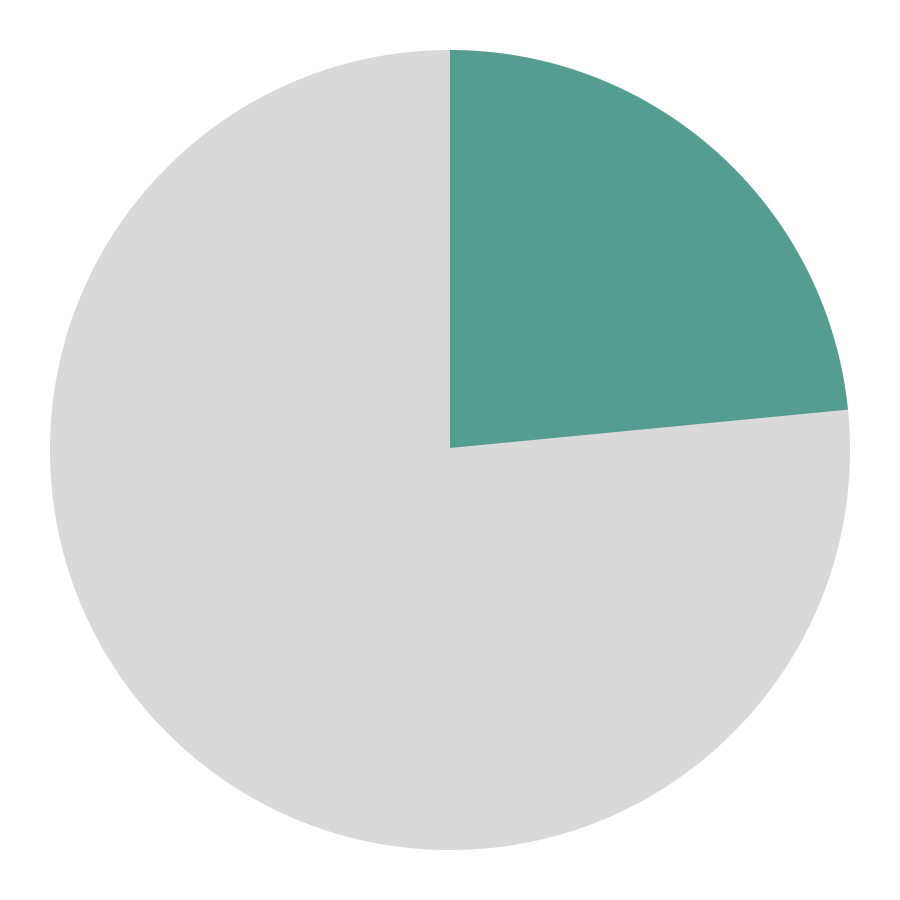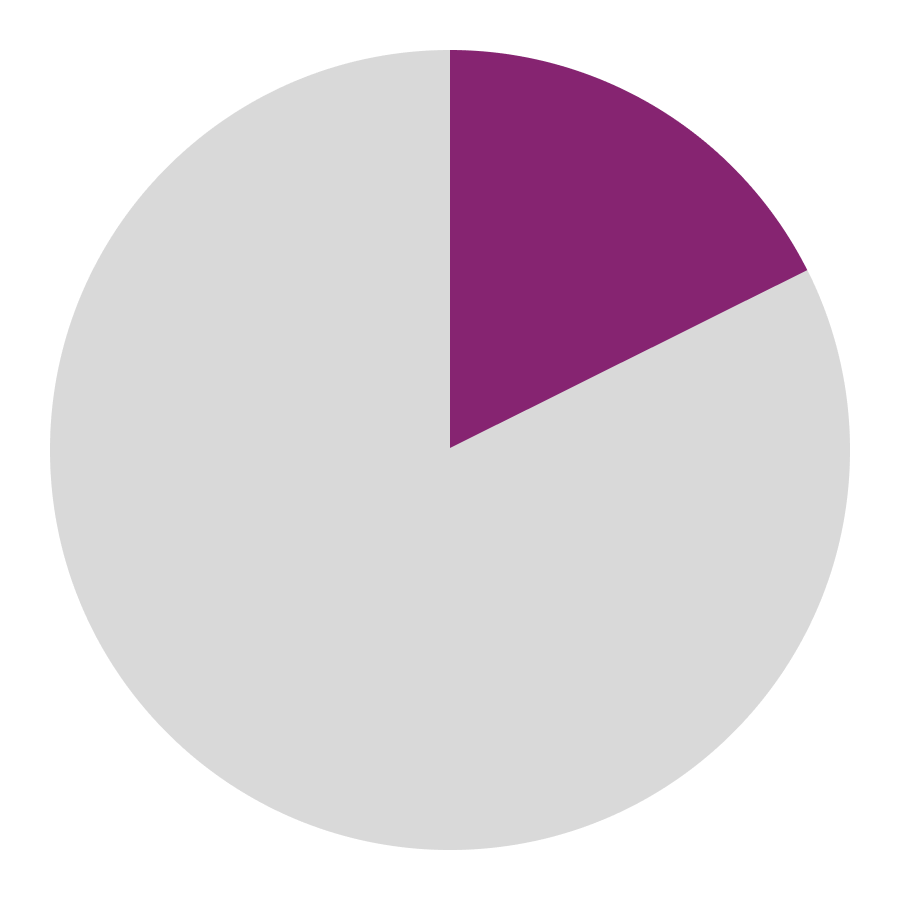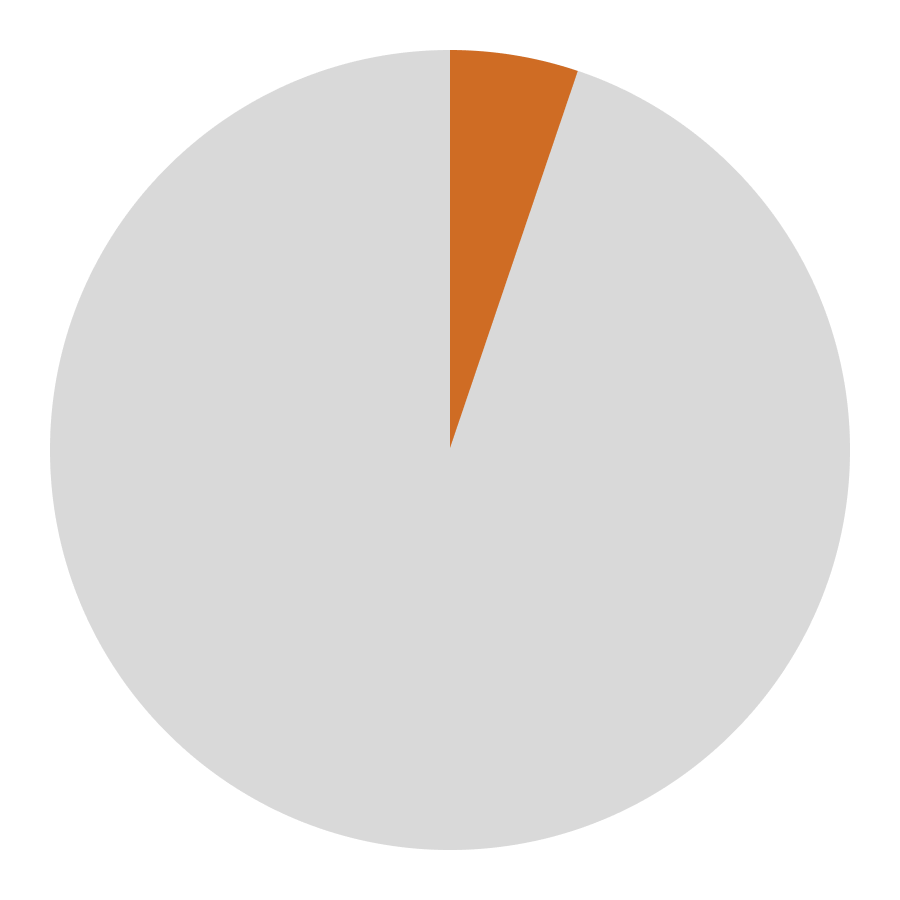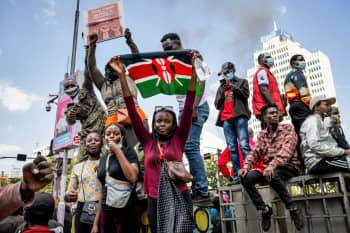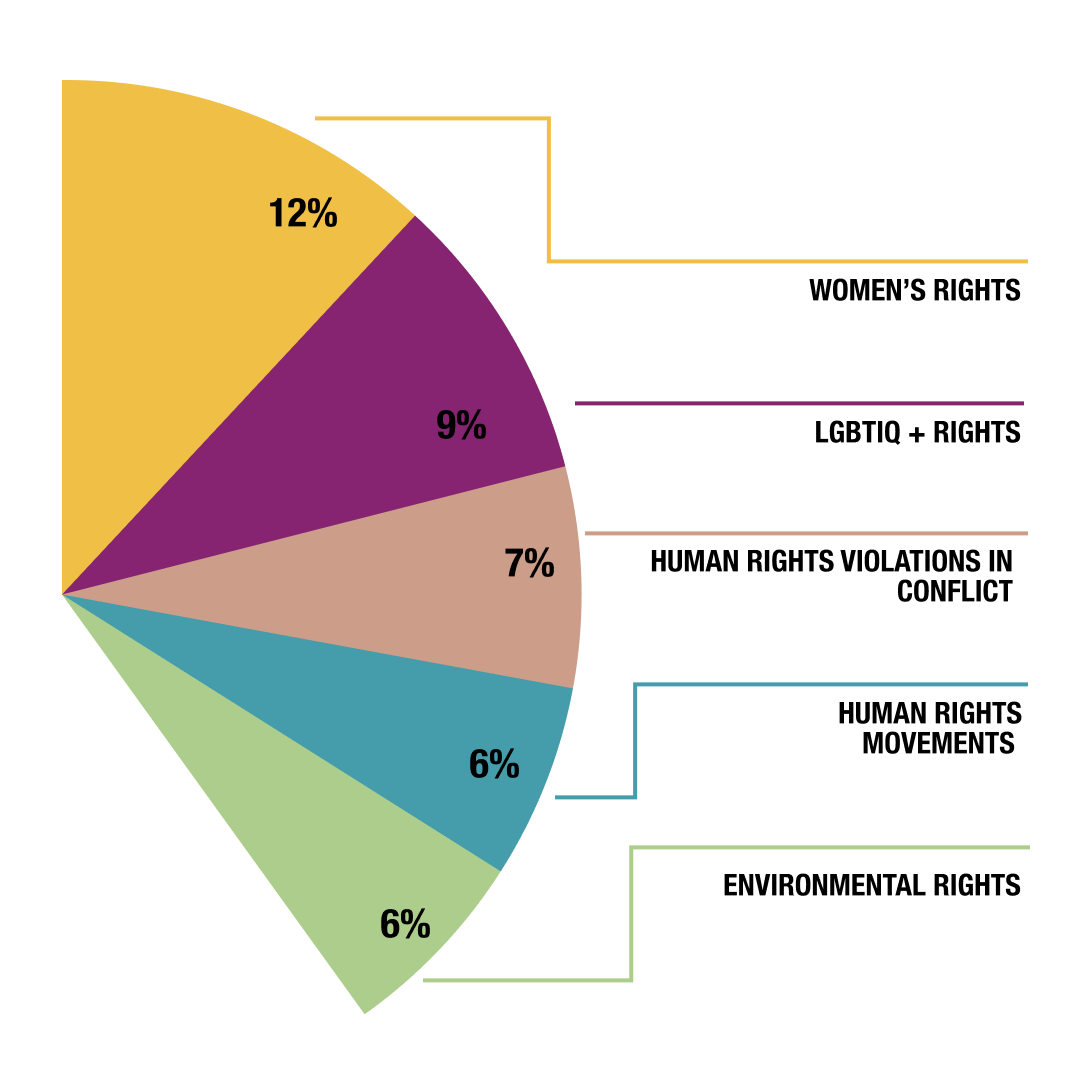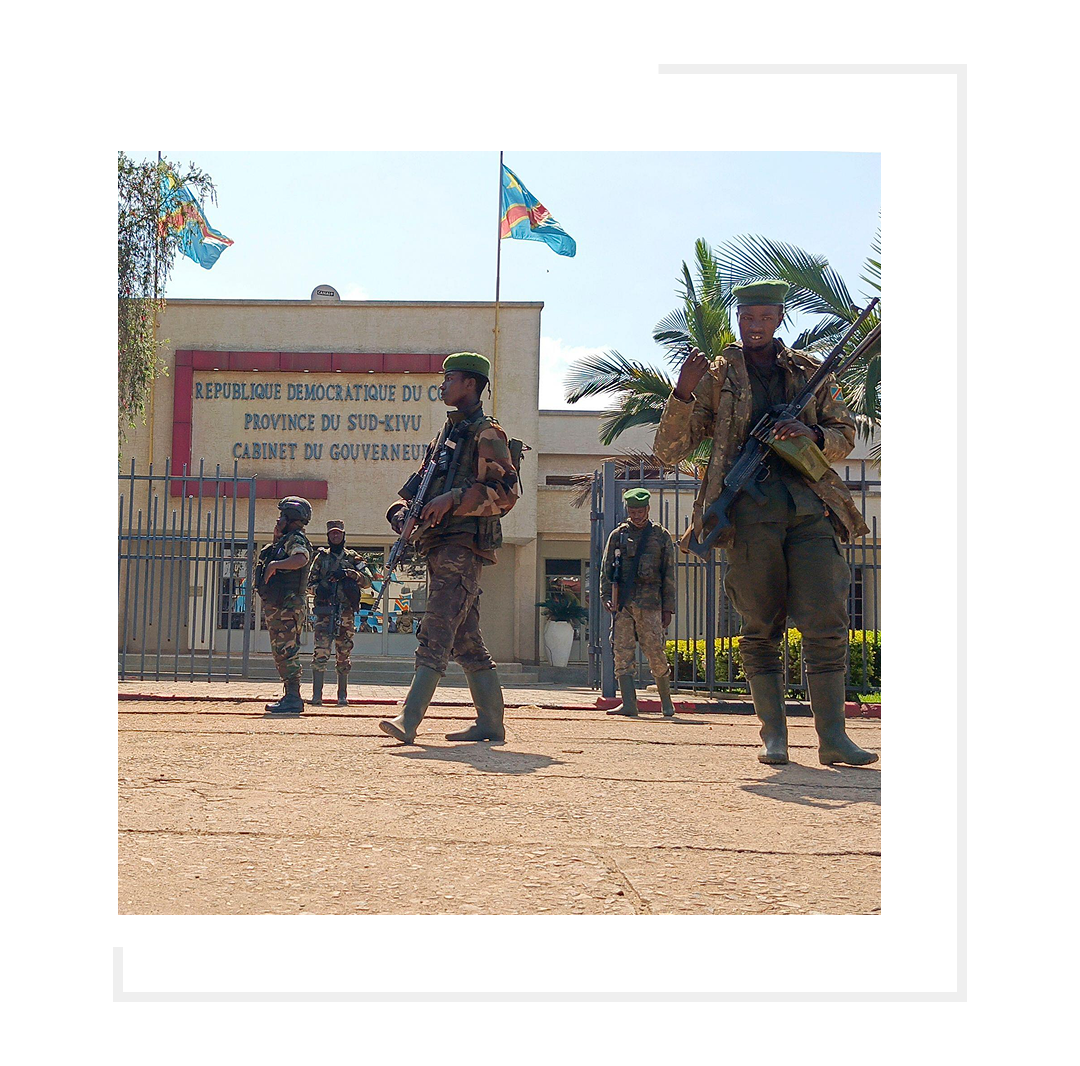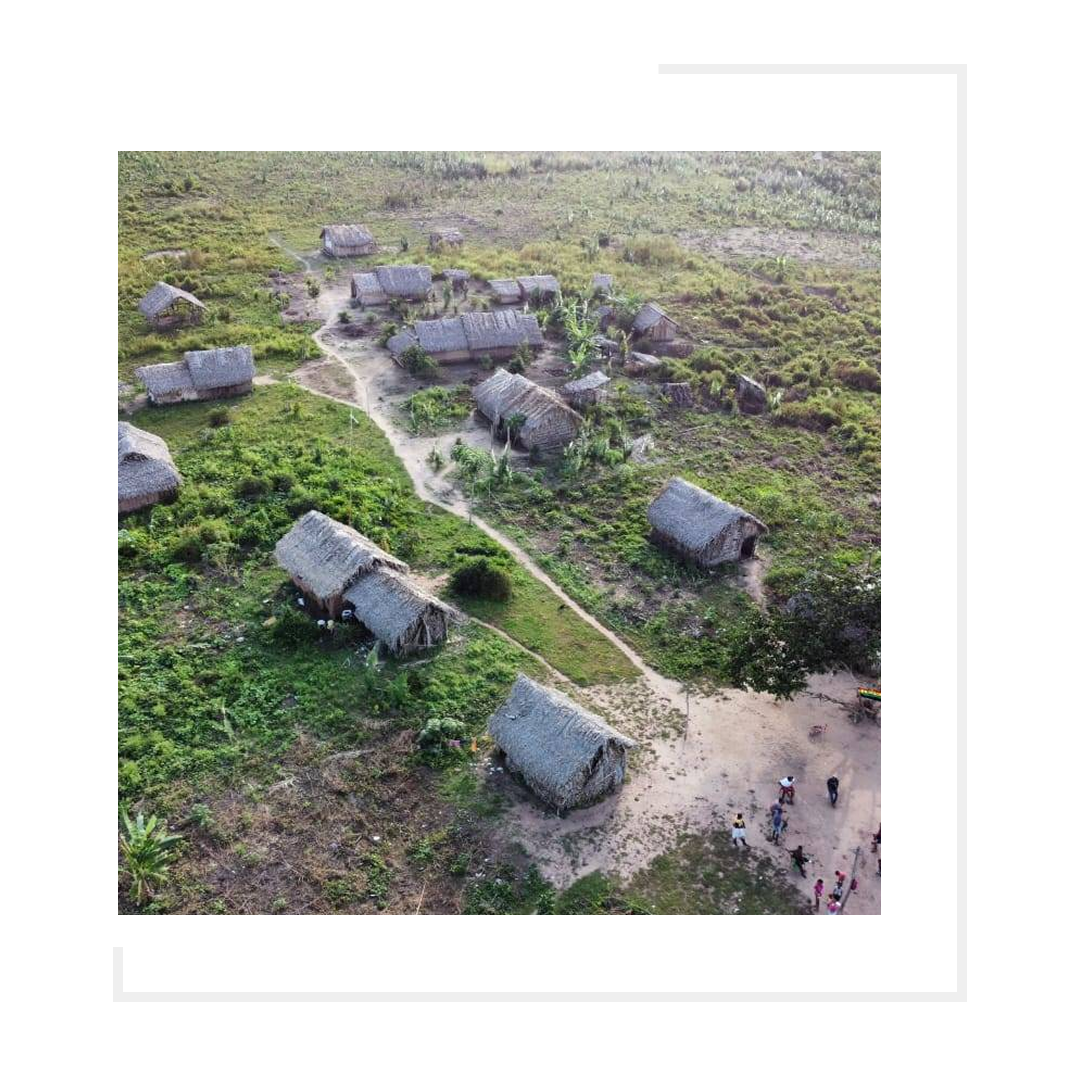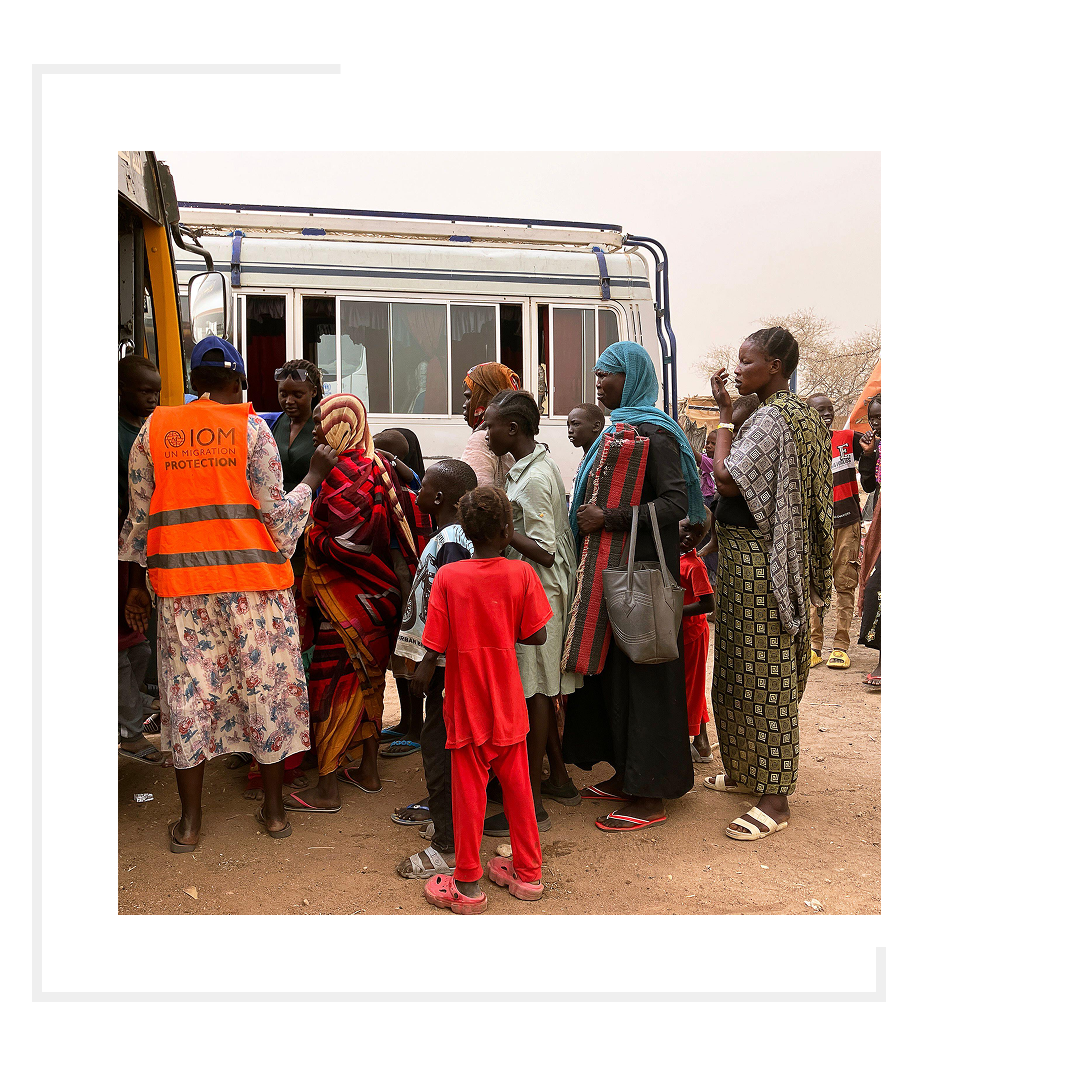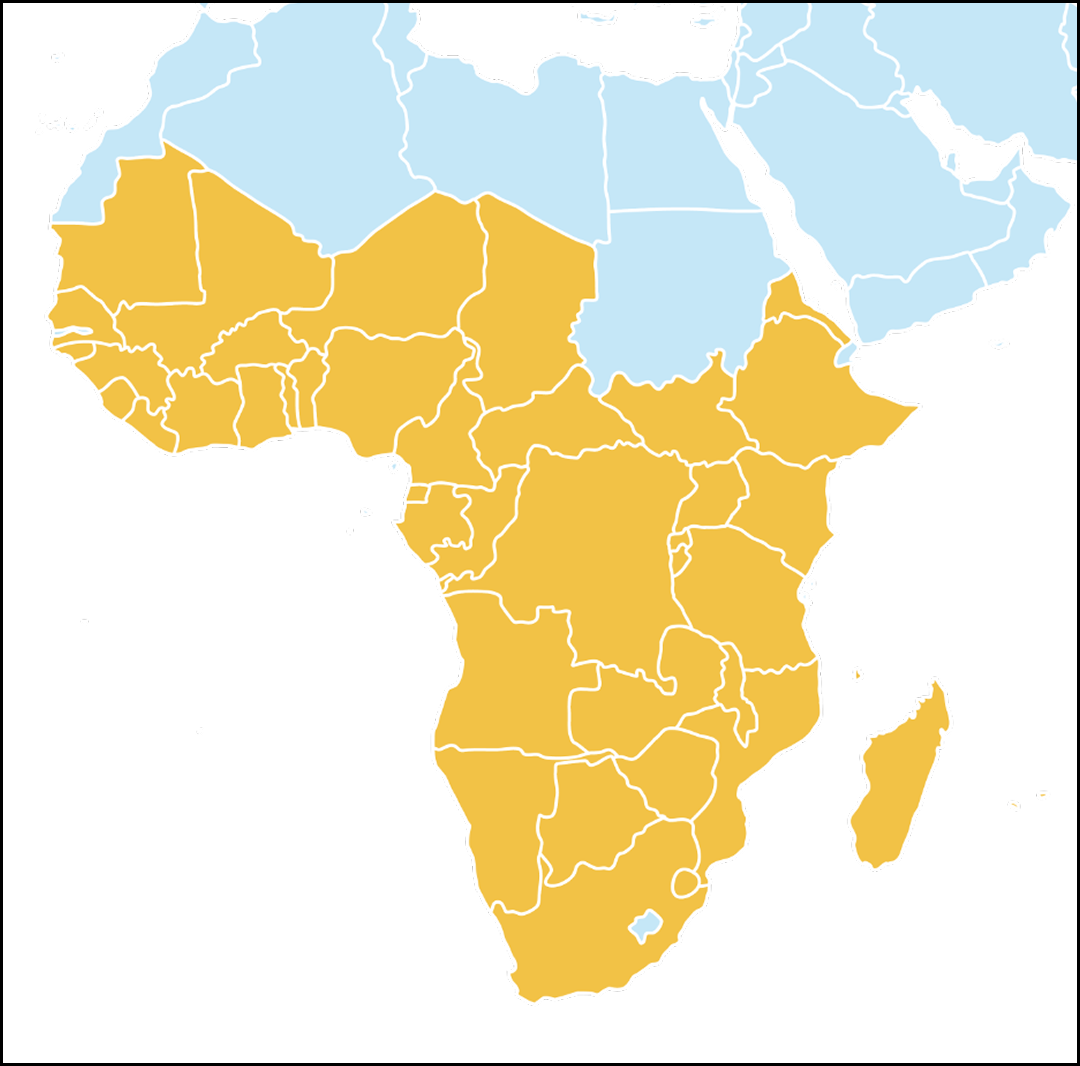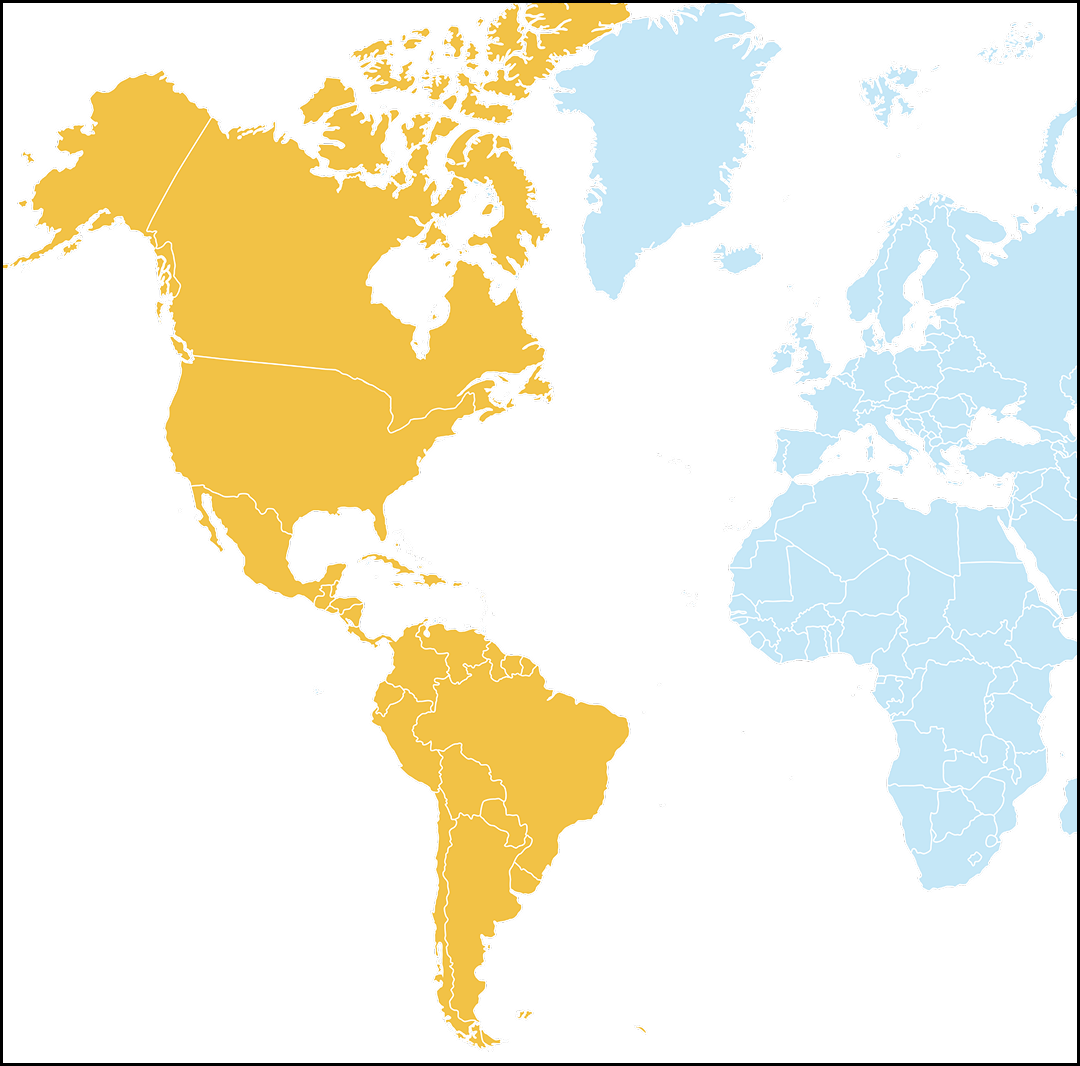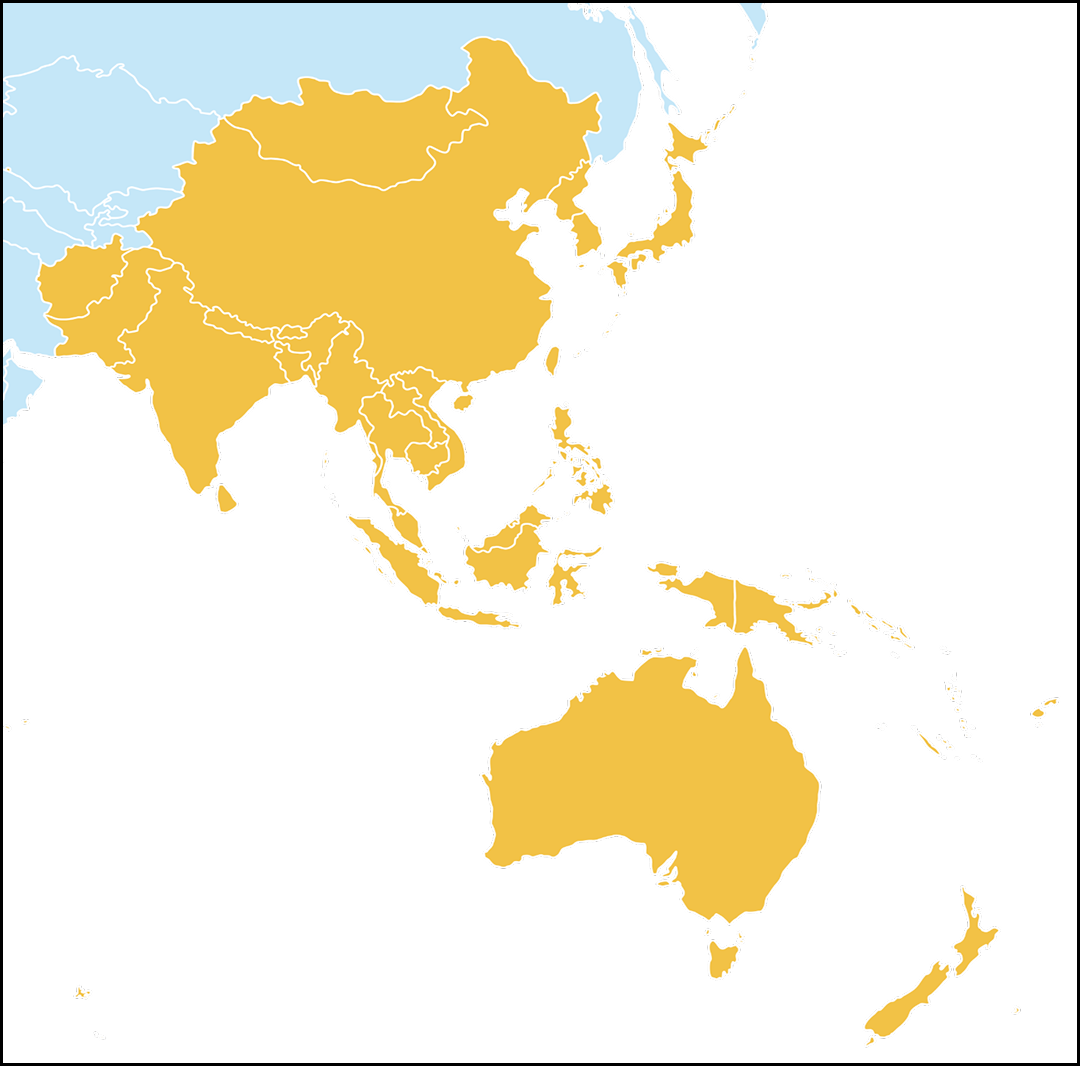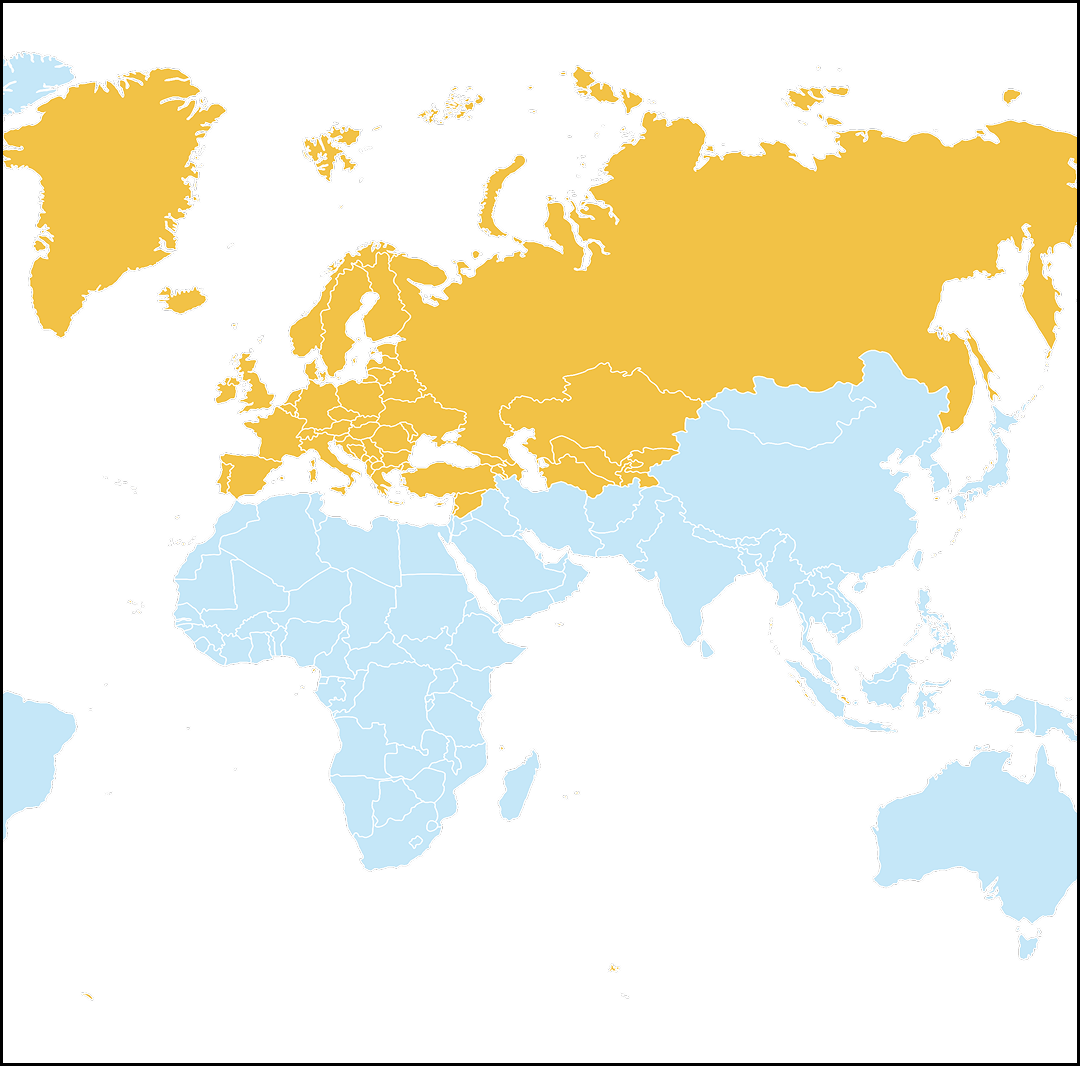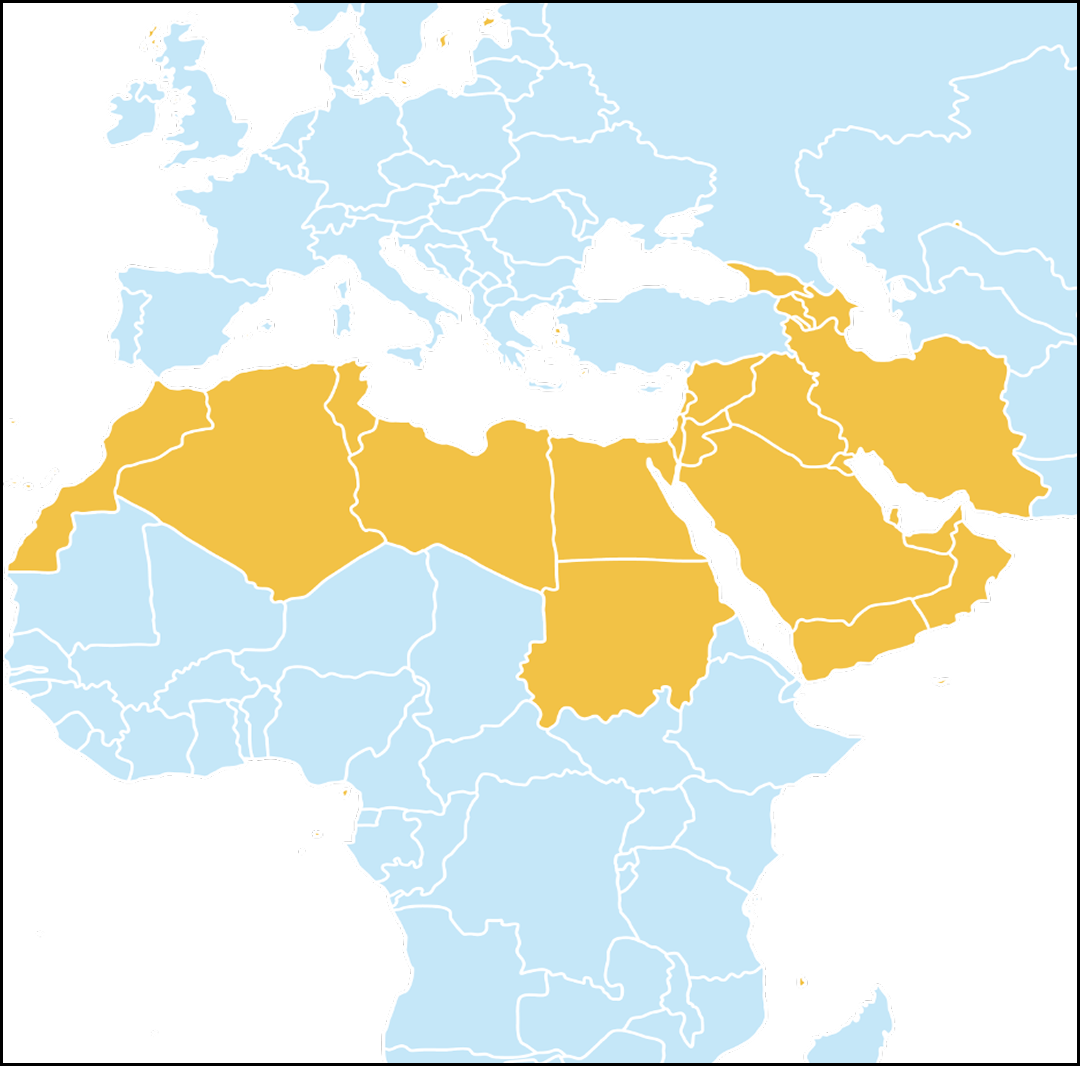GLOBAL ANALYSIS 2024/25
Front Line Defenders Global Analysis is an annual publication, based on the organisation's work, on the situation of human rights defenders (HRDs) at risk around the world detailing the variety of risks, threats and attacks faced by HRDs around the world.
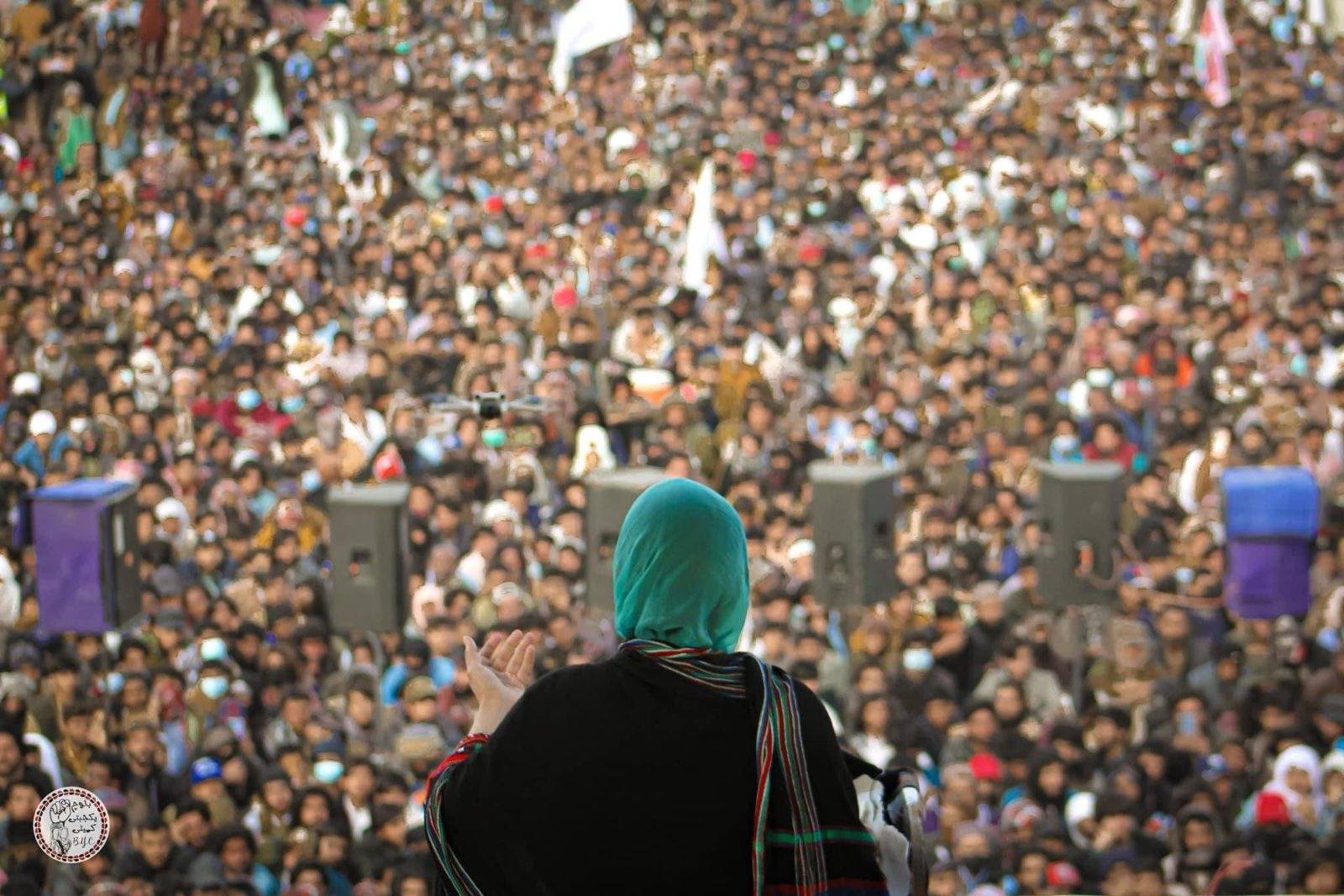
AT LEAST 324 HUMAN RIGHTS DEFENDERS FROM 32 DIFFERENT COUNTRIES WERE KILLED IN 2024 IN AN ATTEMPT TO SILENCE THEM AND THEIR WORK.
HUMAN RIGHTS DEFENDERS MEMORIAL
The HRD Memorial is a joint, global initiative by a network of human rights organisations committed to the protection of human rights defenders and the documentation of killings including: ACI-Participa (Honduras); Amnesty International; Comitê Brasileiro de Defensoras e Defensores de Direitos Humanos (Brazil); Comité Cerezo (Mexico); FIDH; Front Line Defenders; Global Witness; Human Rights Defenders’ Alert– India; Karapatan (the Philippines); OMCT; El Programa Somos Defensores (Colombia); Red TDT (Mexico); and UDEFEGUA (Guatemala).
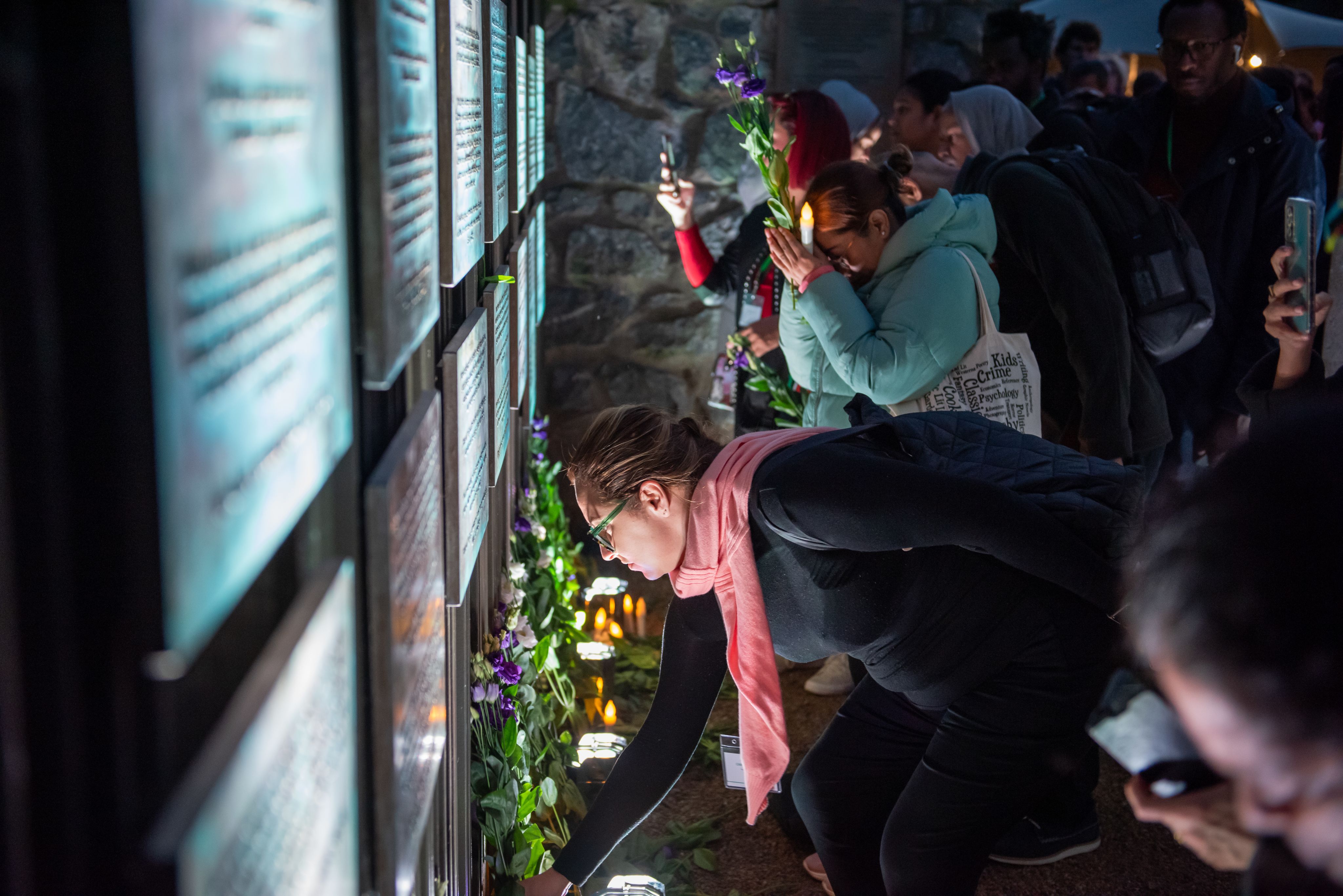
KILLINGS BY REGION
KILLINGS BY GENDER
PERPETRATORS OF KILLINGS
THE HIGH RISK WORK OF DOCUMENTERS
Human rights documenters, both individuals and organisations, take immense risks to verify and report on killings of HRDs in areas, regions and countries affected by conflicts, genocide, mass displacement, under repressive regimes and dictatorships. They often put their own lives in danger, risking detention, torture and murder, to make sure the truth is known, justice is achieved, and the legacy of hundreds of human rights defenders killed every year is not forgotten. The HRD Memorial acknowledges and expresses its profound respect to their work.
20.4% OF HRDS KILLED WERE LAND DEFENDERS1
17.9% OF HRDS KILLED INDIGENOUS RIGHTS DEFENDERS2
5.2% DOCUMENTED HUMAN RIGHTS VIOLATIONS IN CONFLICT3
GLOBAL OVERVIEW
2024 was a year of elections, and with voting taking place in over 80 states, the outcome of these elections highlighted the scale of public dissatisfaction around the world. In one country after another, governing parties lost large shares of their vote or were ejected from power. In some countries, including Kenya and Bangladesh, changes were forced by the streets, and incumbents had to shift direction or leave power in response to massive protests. Electoral change, however, did not necessarily mean a better situation for human rights defenders (HRDs), who witnessed the deepening cracks in the post-World War II rules-based international order designed to maintain peace and security, and to protect human rights.
United States President Donald Trump’s victory in the November elections presaged a dramatic change in the US government’s approach to the world, its international commitments and its support for an international order which, in theory at least, prioritises human rights. Shortly after taking power, the Trump administration removed human rights protections and weakened accountability frameworks, as the new President attempted to embed a system that favours corporate interests, the wealthy and the most powerful at home and abroad, all the while giving voice to the worst excesses of far-right ideology. Given the US’s previous role as the world’s largest humanitarian donor, and leaving aside arguments about how such a system of unequal power came about, the impact of the funding cuts on human rights is profound.
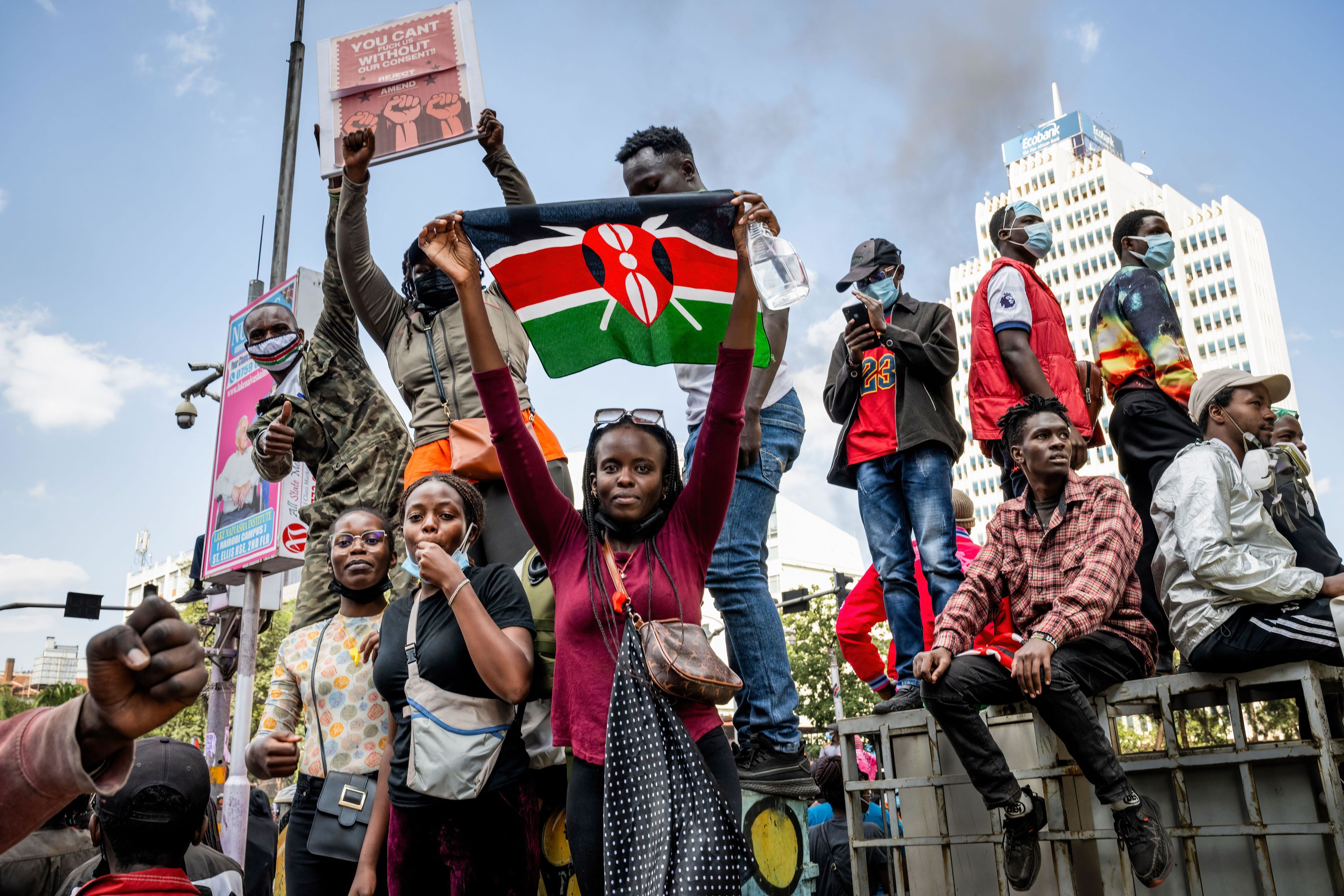
CRIMINALISATION: THE MOST REPORTED VIOLATION AGAINST HRDS
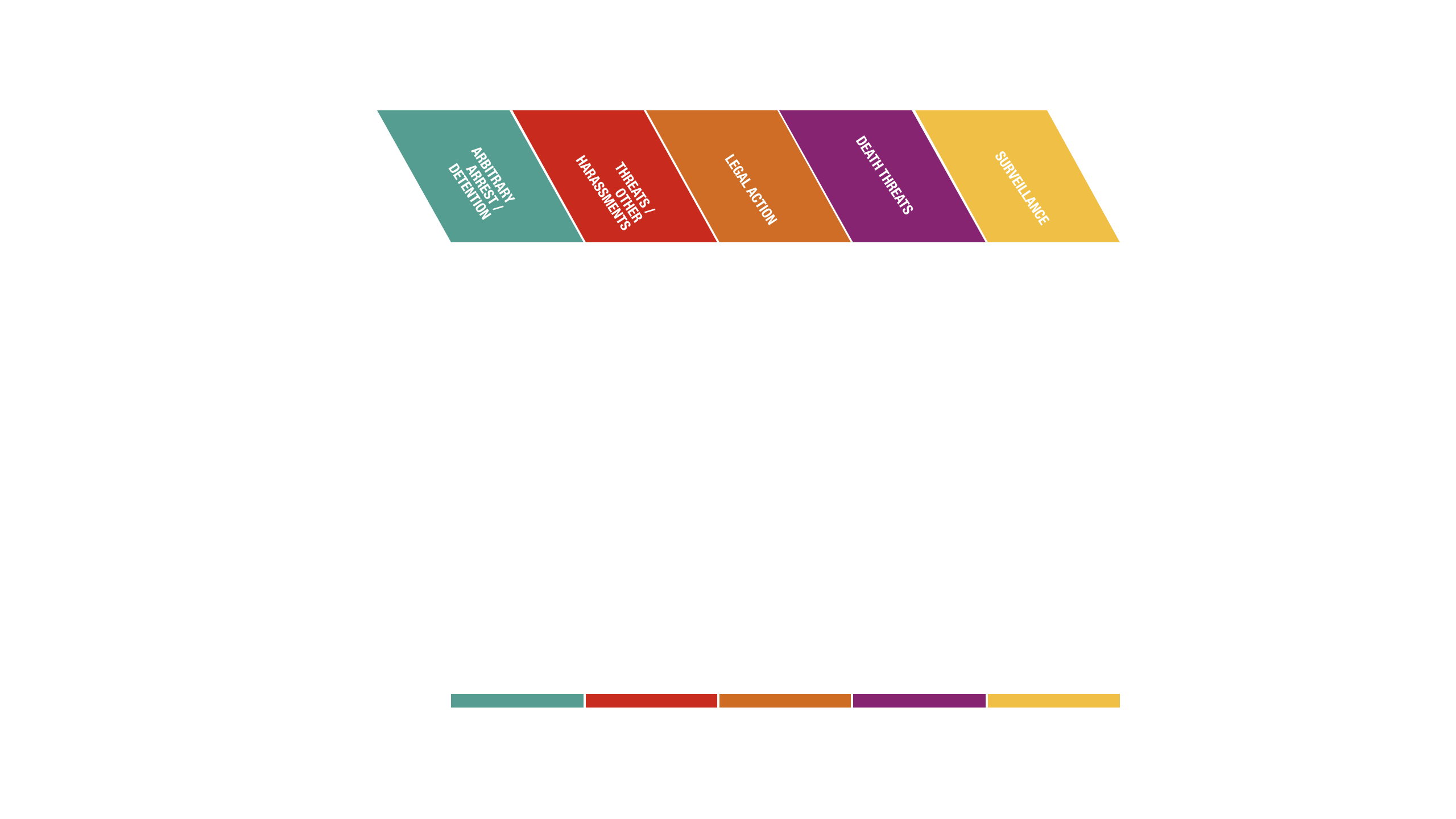
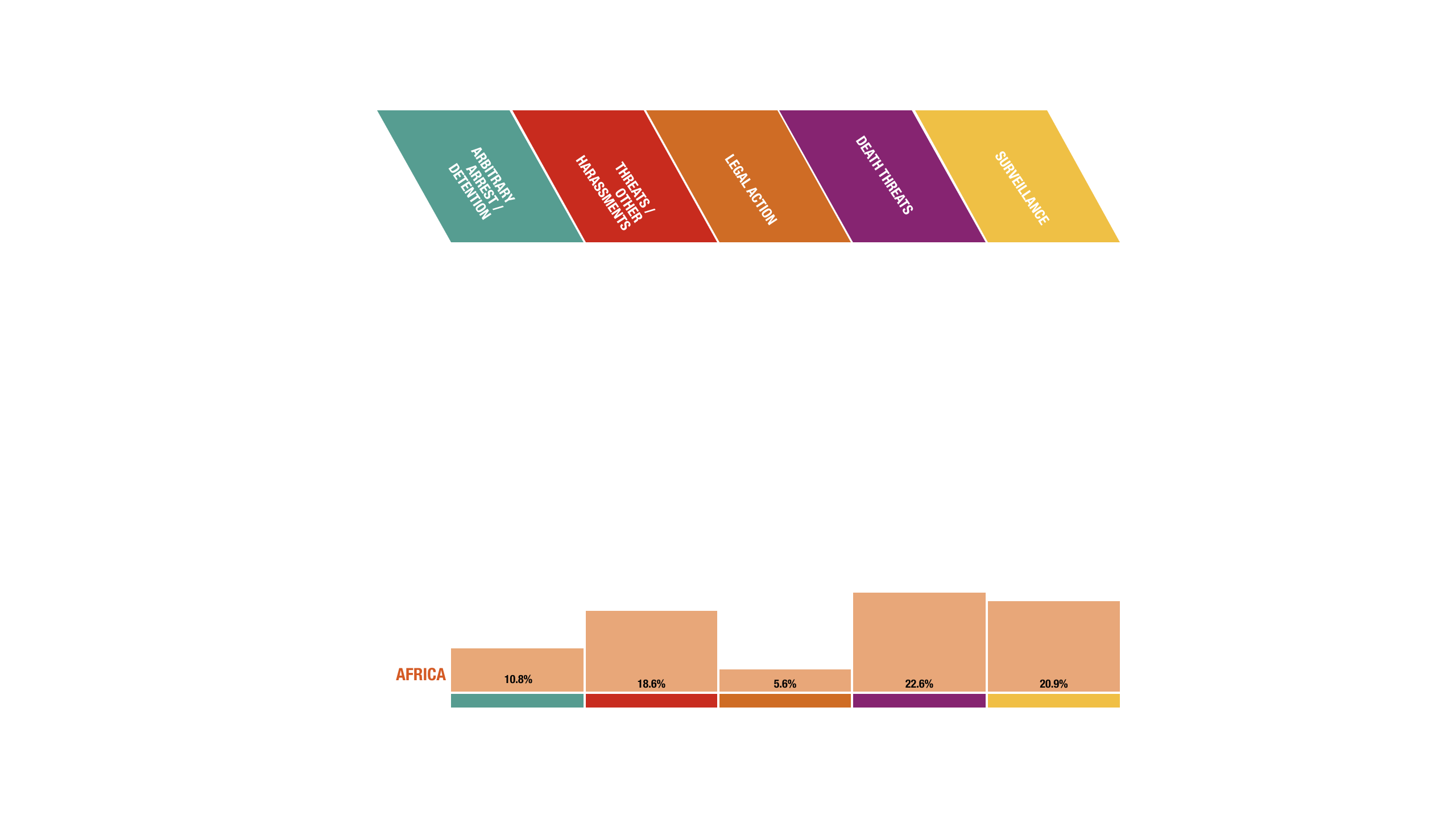
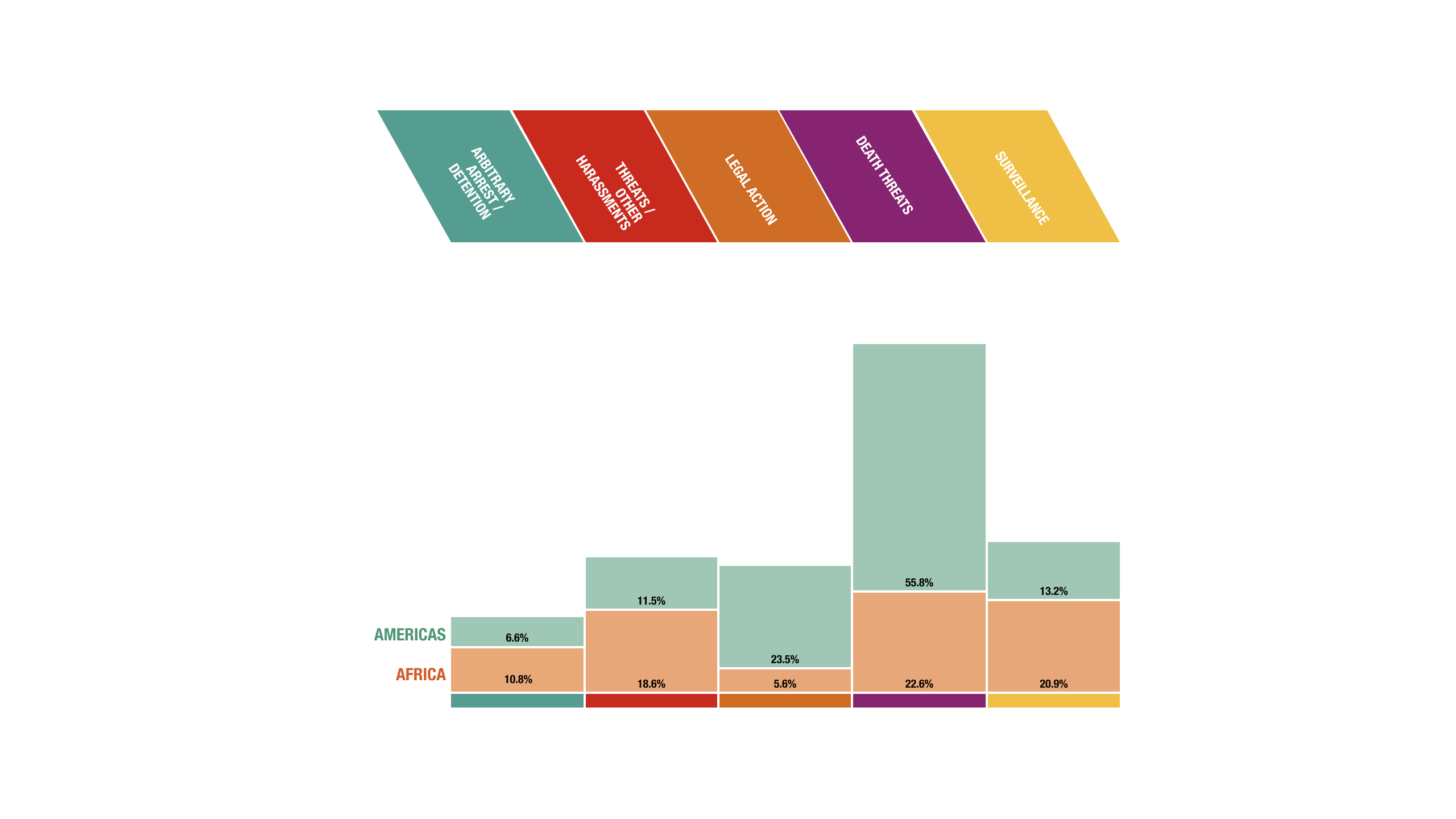
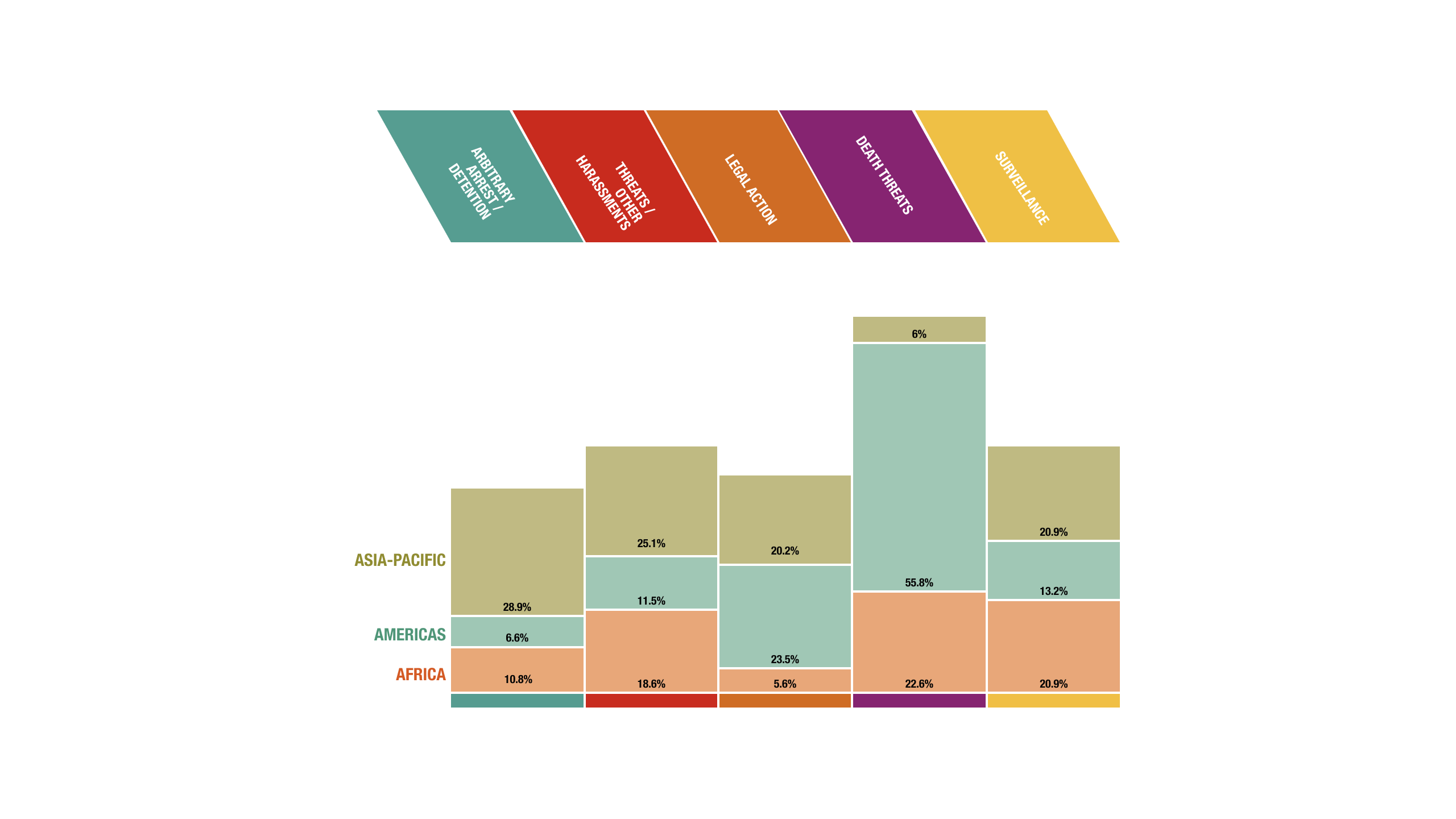
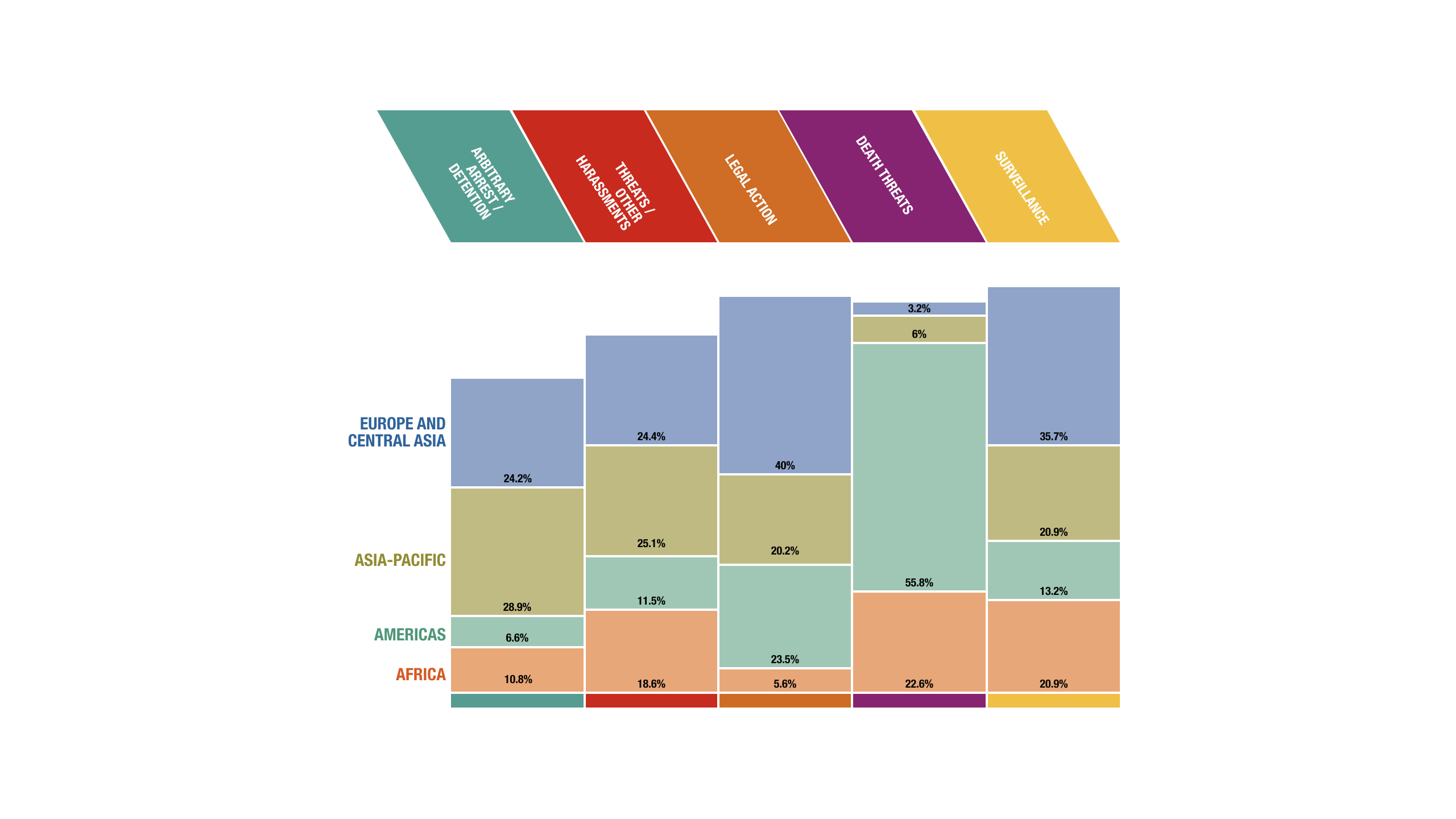
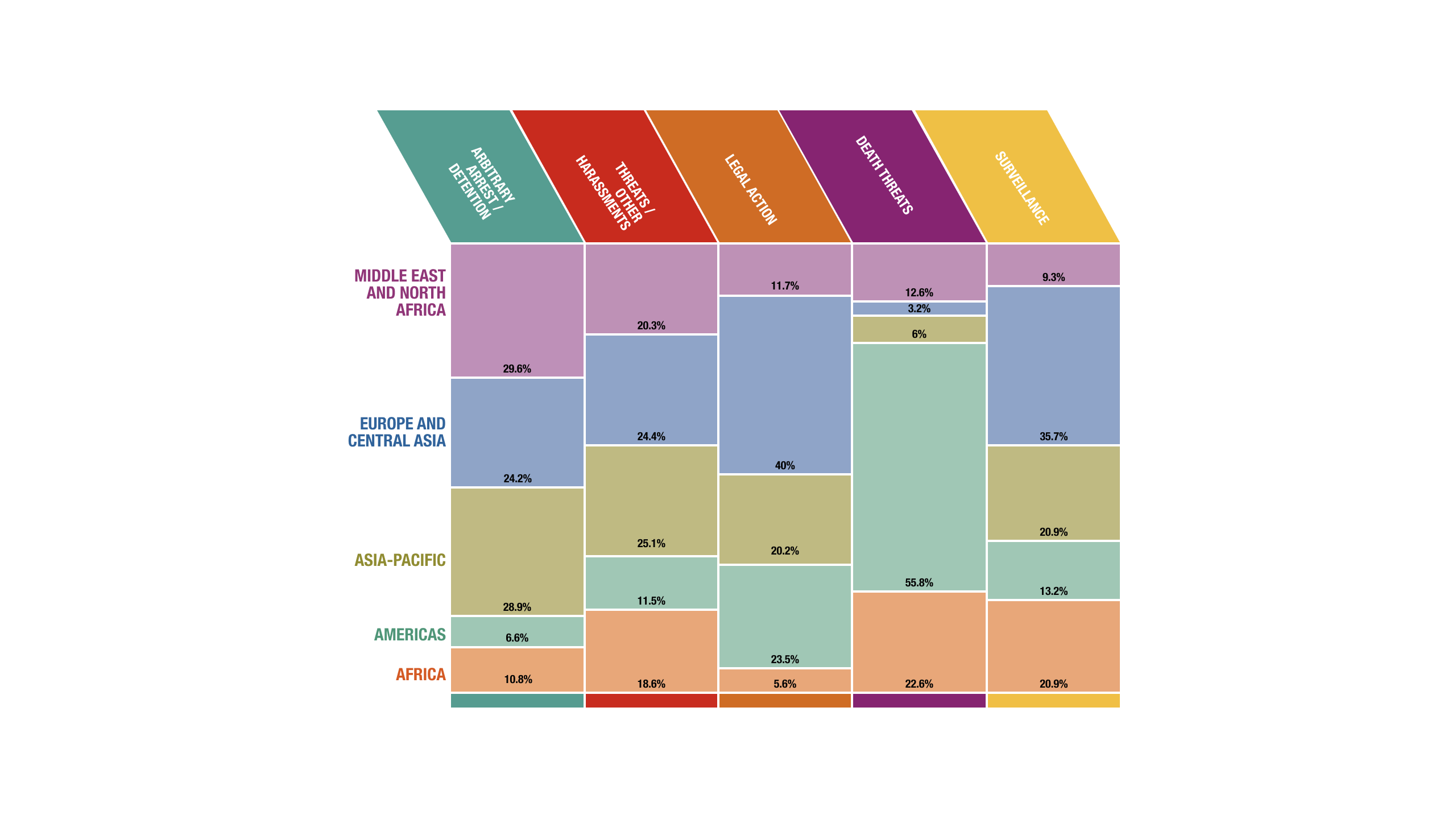
In every region, governments and non-state actors turned to judicial systems to disrupt, tie up, stigmatise, bankrupt and imprison HRDs, regardless of the human rights they were defending. Laws designed to keep the public safe were weaponised to keep governments safe instead. This was blatantly exemplified in Zimbabwe in the lead-up to the Southern African Development Community (SADC) Summit in August when over 160 HRDs, activists, opposition politicians and students were arbitrarily and pre-emptively detained to prevent any protests highlighting human rights violations during the meeting
MOST REPORTED VIOLATIONS AGAINST HRDS BY GENDER
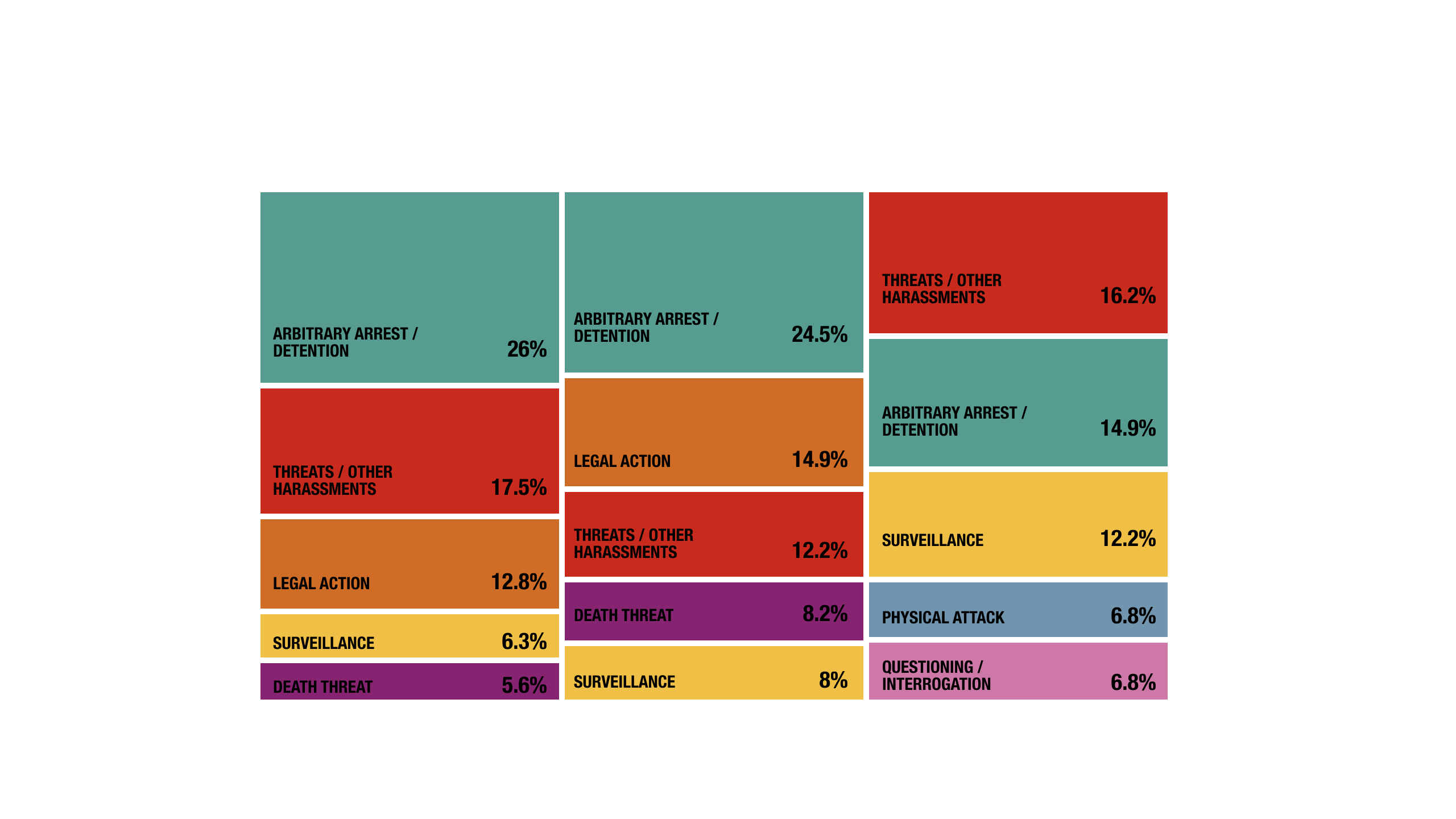
WHRDs continued to pay with their lives for working outside the home instead of staying within the private sphere as dictated by patriarchal norms; for going to school or university; for ‘daring’ to live their sexuality openly. Furthermore, women were targeted as a way to threaten their relatives who were engaged in human rights work, and as documented in previous years, the targeting of family members is a violation that often goes under-reported.
In the context of criminalisation of social movements and protest, repression against women activists engaged in struggles often takes the form of sexual violence.
Furthermore, discrimination against women is compounded by the intersection of different modes of oppression: they are discriminated against for being women, but also because of their skin colour, language, race, ethnicity, class (and financial situation), religion and sexuality.
According to Front Line Defenders’ data from 2024, it was defenders working specifically on women’s rights who were among the most targeted and most in need of support. In the context of a global backlash against women’s rights, WHRDs who persisted in their advocacy were on the frontlines.
5 MOST COMMONLY CITED LEGAL CHARGES AGAINST HRDs*
*Based on 107 charges filed in 75 cases

Governments continued to pay lip service to human rights on the international stage while at the same time narrowing the avenues through which HRDs could realise those rights without being prosecuted. Foreign Agent Laws, which stigmatise or penalise organisations and individuals who receive funding from foreign entities, were drafted or introduced in a number of countries, including Georgia and Serbia. At a time when traditional funders of human rights reduce their funding or turn away from providing aid altogether, these laws further weaken the capacity of defenders to organise and deliver on the promise of human rights in their countries. Chinese authorities introduced stifling new legislation in Hong Kong with the National Security Law, which is clearly designed to obliterate human rights activism. The provisions of this law are so broad and vague that even interactions with the United Nations Human Rights Mechanisms are potentially criminalised.
AREAS OF HUMAN RIGHTS DEFENCE
The percentages shown reflect the five most targeted groups of HRDs by area of human rights defence, as a proportion of the total number of documented violations.
PRIDE AND EQUALITY: FIGHTING FOR LGBTIQ+ RIGHTS
The struggle for the equal treatment of LGBTIQ+ persons remained hard fought in many countries. Rays of hope for the legalisation of same-sex marriage in Thailand, Estonia and Greece, and of same-sex civil unions in Czechia, were overshadowed by negative developments elsewhere. The Ugandan Constitutional Court upheld the dehumanising 2023 Anti-Homosexuality Act while Liberia introduced a similarly regressive law, the Anti-Homosexuality Law of Liberia 2024 Bill, to parliament in July. The Constitutional Court in Malawi rejected a challenge to sections of the penal code which criminalise homosexual relationships and in Ghana, the Human Sexual Rights and Ghanaian Family Values Act was passed in parliament in February.
What is also notable about the risks faced by LGBTIQ+ defenders is the variety of ways in which they are targeted, ranging from arrest, attempted killing, death threats and disappearances to physical attack, break-ins, smear campaigns and other gender-related threats.
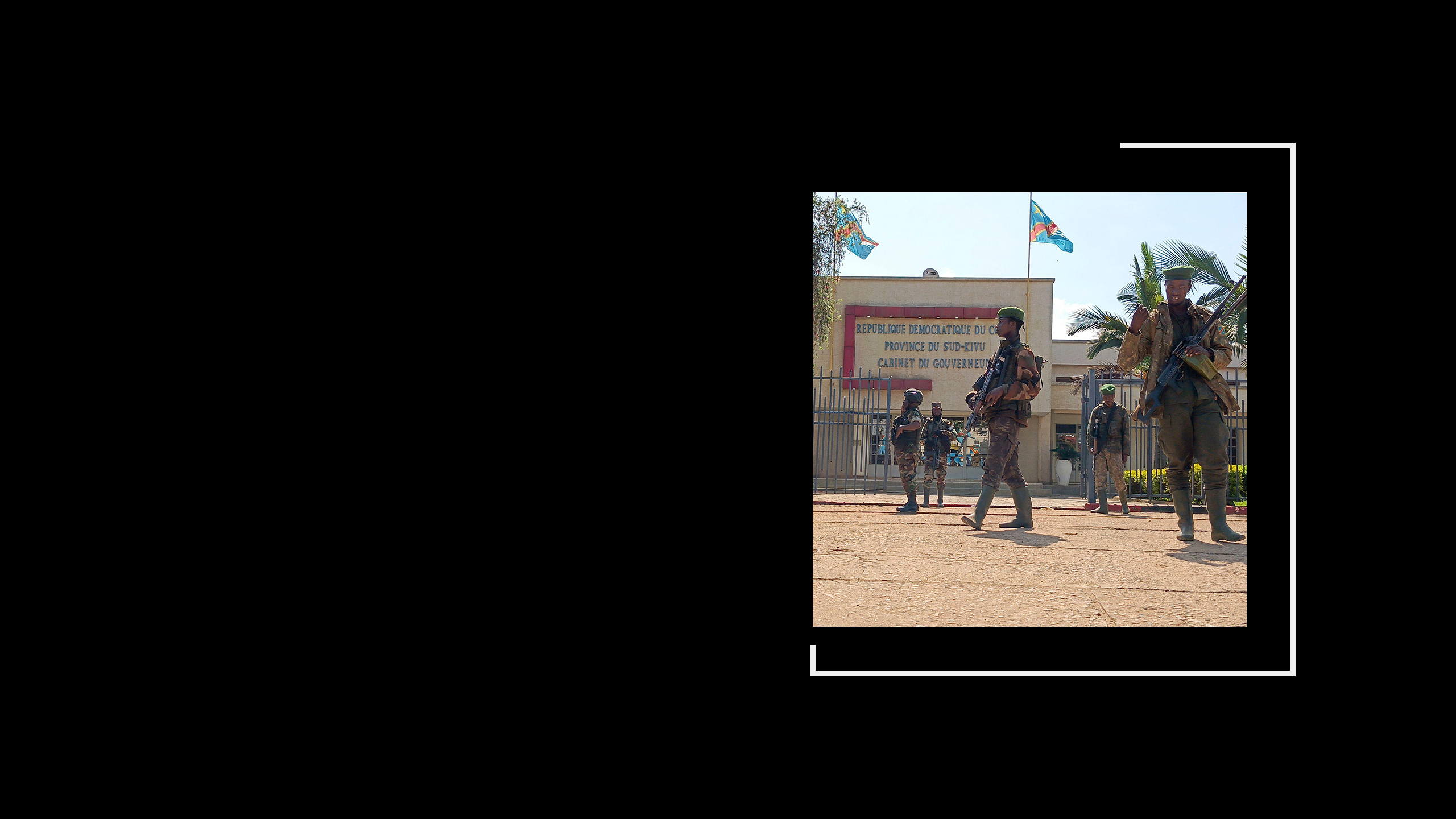
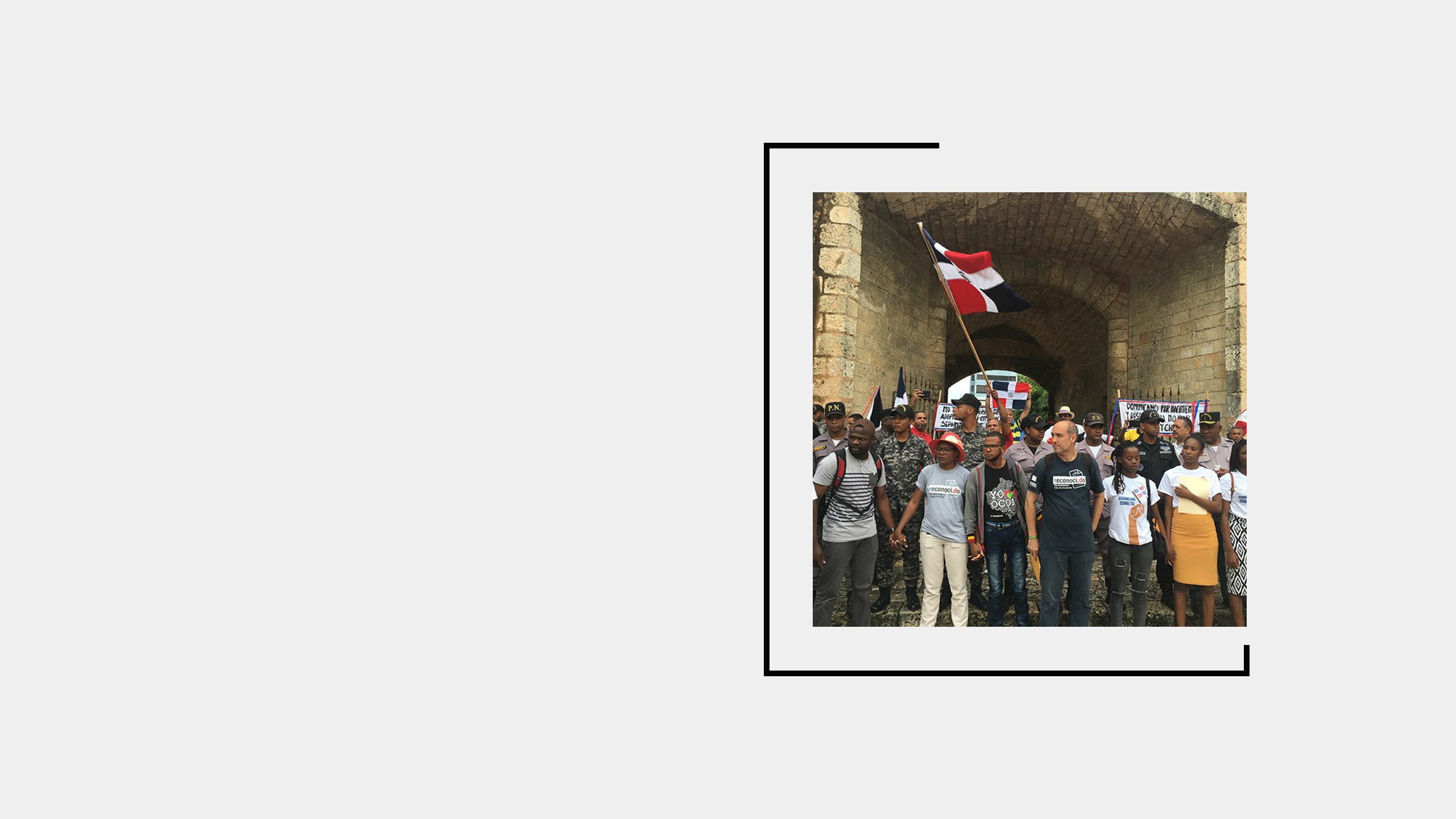
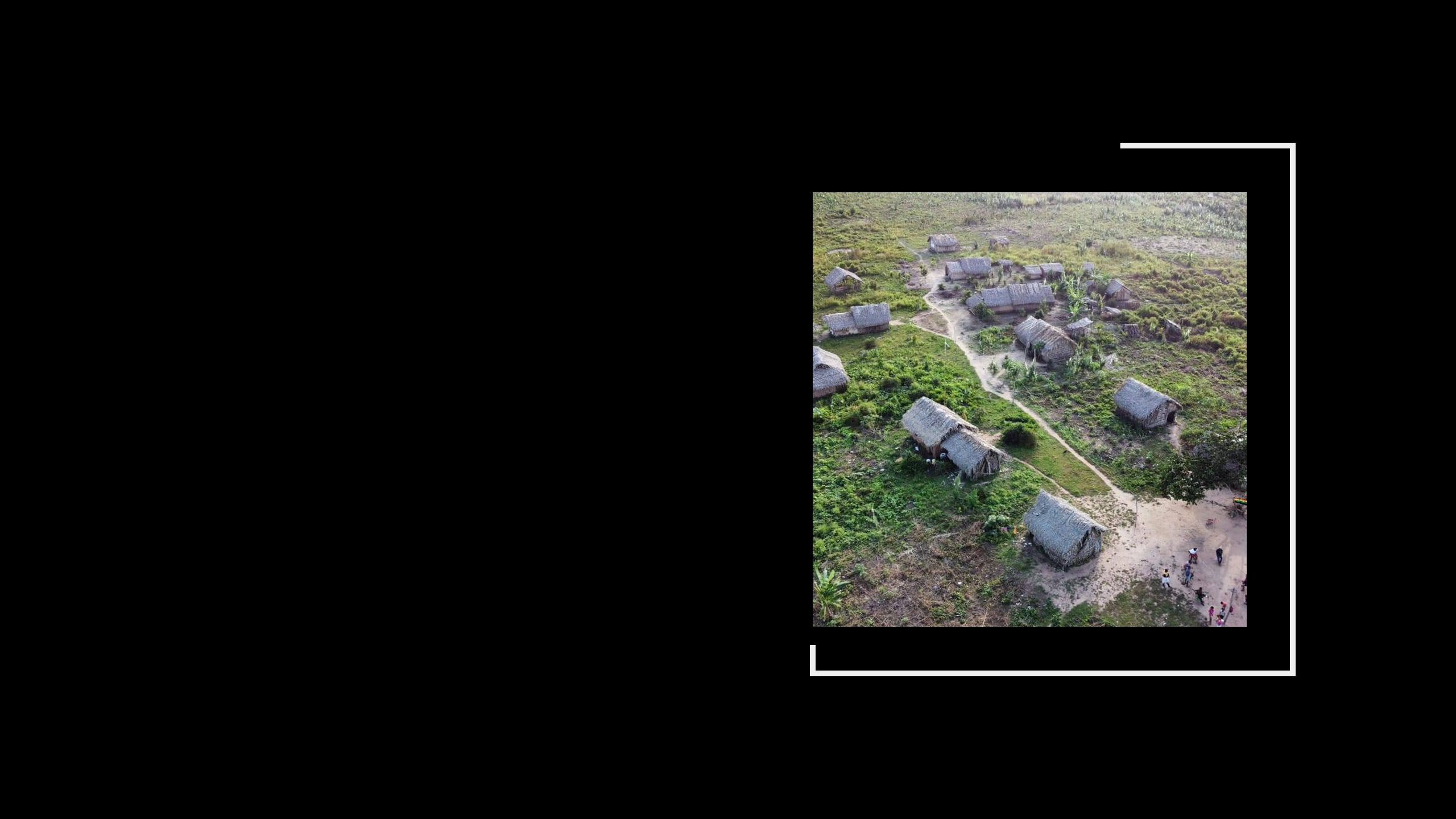
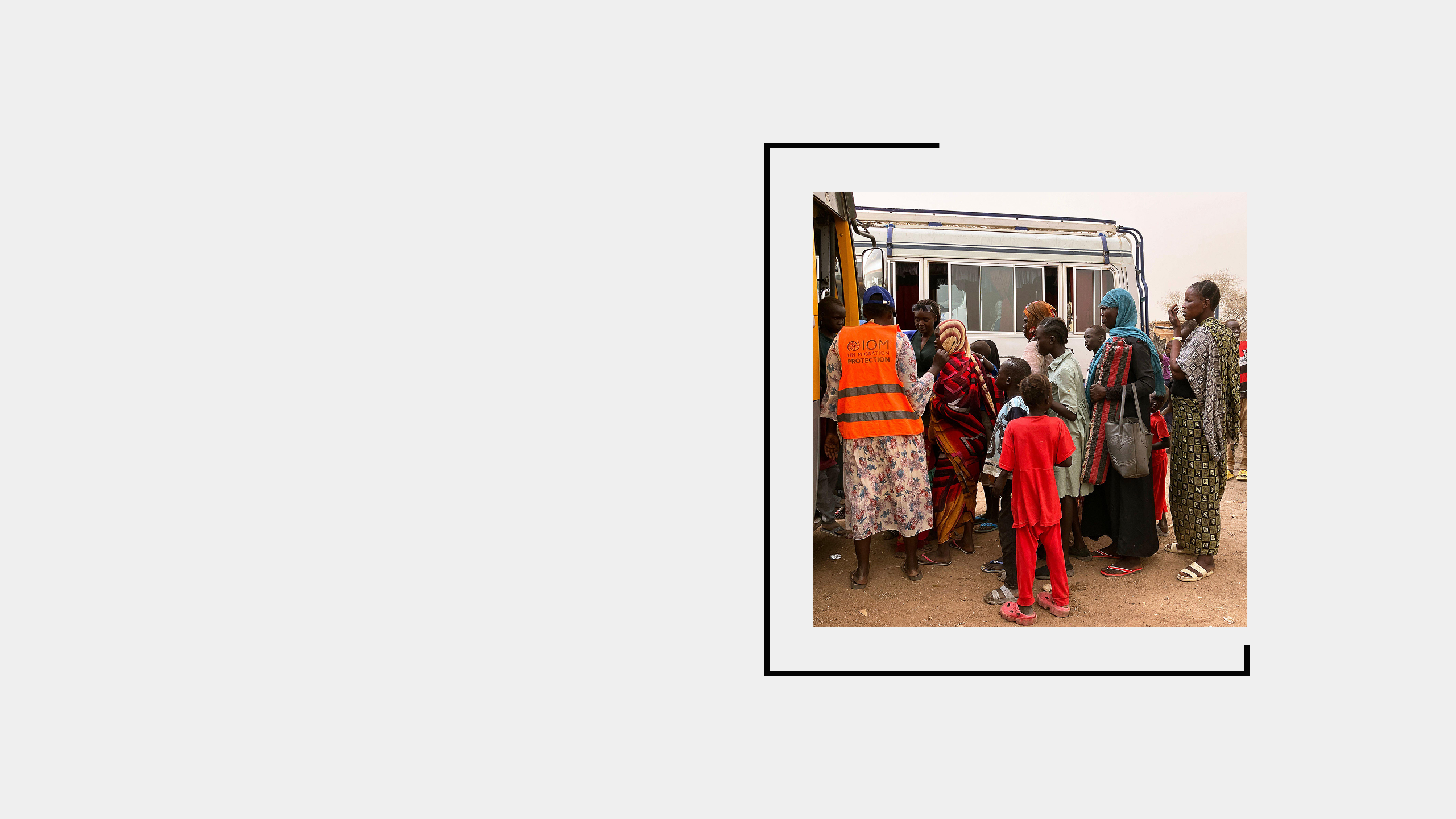
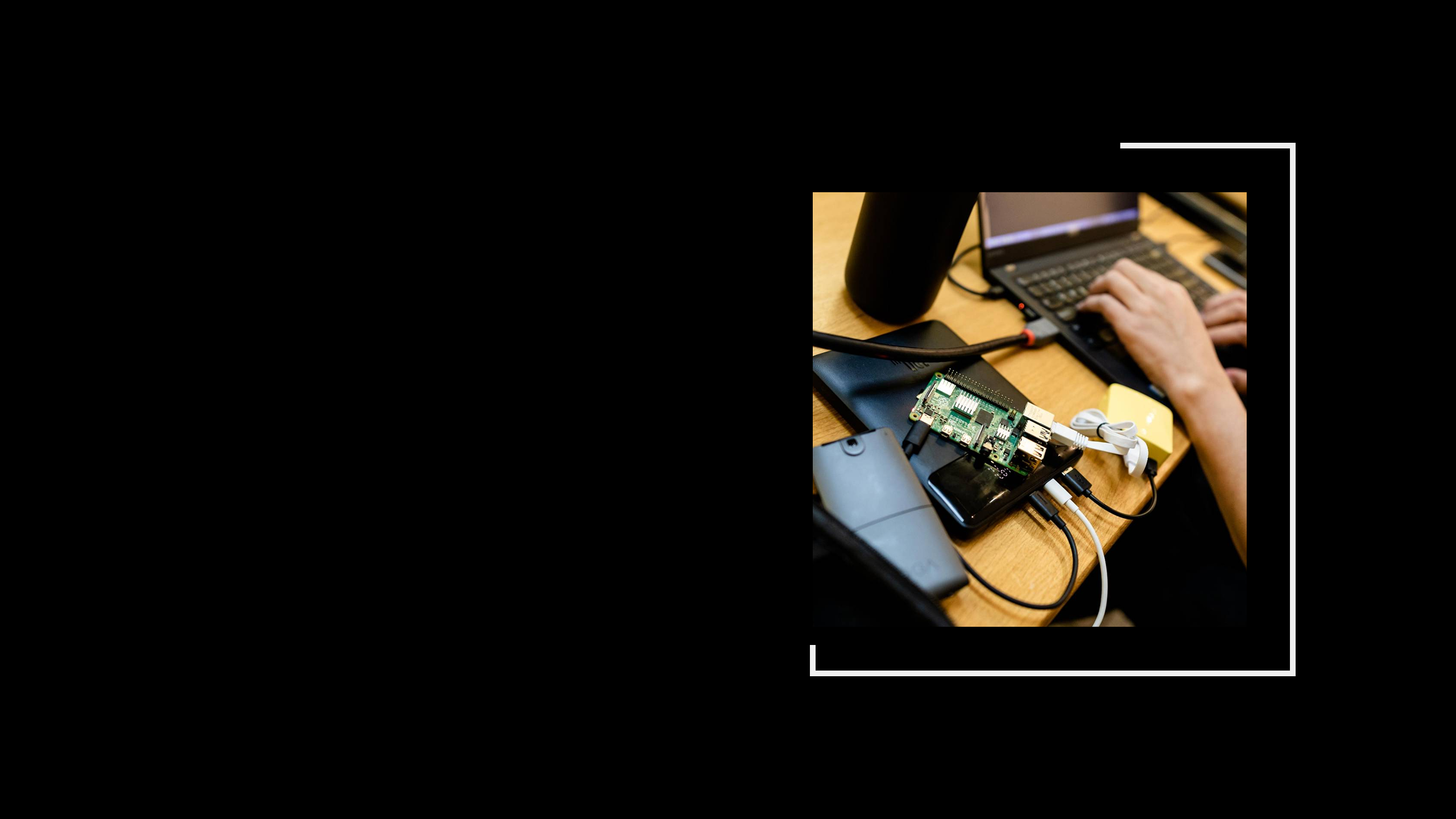
CONFLICT, POST-CONFLICT AND CRISIS SITUATIONS
In a year characterised by UNICEF as “one of the worst years in history for children in conflict”, HRDs working in conflict and post-conflict areas were pushed to the limit by both conflict-related violations and a lack of support. HRDs working in wars and crisis situations including in Sudan, Ukraine, Myanmar, Ethiopia, DRC, Kashmir, Afghanistan, Colombia, Mexico, Occupied Palestinian Territory and Syria faced immense challenges, including threats to their safety, restricted access to populations in need and heightened risks of systemic violence.
FREEDOM OF ASSEMBLY
The window of mainstream public discourse on permissible forms of protest is being dragged further and further away from what is permissible under international human rights law. HRDs engaging in peaceful protest were subjected to most frequently to arbitrary arrest and detention, but also numerous other rights violations, including physical violence, harassment, travel bans, house raids, and legal action. Such treatment occurred in countries in every region, including in Bangladesh, El Salvador, Uganda and Iran. The crackdown on peaceful anti-war protests in the US and Germany highlighted the great distance in terms of policy that authorities in both countries had travelled from previously championing international human rights standards on freedom of assembly.
LAND, INDIGENOUS AND ENVIRONMENTAL RIGHTS DEFENDERS
In late 2024 and early 2025, a host of businesses, corporations and institutions in the US announced a significant weakening of their environmental commitments. As states and businesses continued to squabble at the cost of real change it was left to defenders and communities working on environmental, indigenous people’s rights and land rights – which are often interconnected – to uphold environmental and human rights commitments, and seek corporate accountability for wrongdoings. And for this, they continued to be killed and harmed in great numbers. In 2024, the HRD Memorial was able to verify the killing of 59 HRDs directly or indirectly related to their human rights work challenging business or corporate interests.
Non-state actors, including businesses, paramilitary groups and organised crime, also presented grave risks to HRDs working on land, environmental or indigenous people’s rights. These risks tended to occur in the context of non-state actors wanting to occupy, use or be present in territories where HRDs or their communities were living
SAFER PASSAGE, BETTER PROTECTION
The ability of HRDs to move inside and outside their countries remained a vital protection pathway for them at times of increased or urgent risk. This was evident in the number of such requests Front Line Defenders received from HRDs who were being targeted for their work. Where safe to do so, in-country relocation is the preferred first option. However, in many cases, this is not possible, and in such situations, relocation within the region was the second option for many defenders. Traditionally Costa Rica, Kenya, South Africa, Tunisia, Lebanon, Kyrgyzstan, Georgia and Thailand have all been popular places for HRDs to relocate regionally when the risks they faced at home became too severe.
Even for defenders not looking to permanently relocate, visas remain a tool both for protection and for empowerment. Regrettably, obtaining visas for temporary respite, to attend networking or training events or to participate at UN sessions in Geneva or New York and other advocacy spaces has remained extremely difficult.
Picture credit: DPA
HUMAN RIGHTS DEFENDERS IN THE DIGITAL SPACE
Despite the usefulness of technologies to HRDs such tools were also used to target defenders. They were used for arbitrary or unlawful digital surveillance, censorship, harassment, and smear campaigns. Online attacks also paved the way for physical attacks, including killings, enforced disappearances, arbitrary detention and harassment, as exemplified in the case of Mira Ben Salah mentioned above.
The silencing of defenders online was rampant, particularly in moments of political turmoil or conflict situations. HRDs who played a vital role in documenting and exposing human rights violations at great personal risk increasingly found themselves targeted by digital censorship practices including shadow-banning, content removal, account suspensions and deletions.
The testimonies collected from HRDs focusing on the Occupied Palestinian Territory revealed a concerning pattern in Meta’s content moderation practices that disproportionately affect marginalized and politically sensitive voices.
Fighters from the Rwandan-backed M23 seen outside the South Kivu province administrative office, at the centre of eastern DRC’s second-largest city, Bukavu. © AP Photo/Janvier Barhahiga
Fighters from the Rwandan-backed M23 seen outside the South Kivu province administrative office, at the centre of eastern DRC’s second-largest city, Bukavu. © AP Photo/Janvier Barhahiga
CONFLICT, POST-CONFLICT AND CRISIS SITUATIONS
In a year characterised by UNICEF as “one of the worst years in history for children in conflict”, HRDs working in conflict and post-conflict areas were pushed to the limit by both conflict-related violations and a lack of support. HRDs working in wars and crisis situations including in Sudan, Ukraine, Myanmar, Ethiopia, DRC, Kashmir, Afghanistan, Colombia, Mexico, Occupied Palestinian Territory and Syria faced immense challenges, including threats to their safety, restricted access to populations in need and heightened risks of systemic violence.
Reconoci.do is one of several human rights organisations and HRDs working on migrants’ rights and the rights of Dominicans of Haitian descent, who are subjected to intimidation and violence. © Reconoci.do
Reconoci.do is one of several human rights organisations and HRDs working on migrants’ rights and the rights of Dominicans of Haitian descent, who are subjected to intimidation and violence. © Reconoci.do
FREEDOM OF ASSEMBLY
The window of mainstream public discourse on permissible forms of protest is being dragged further and further away from what is permissible under international human rights law. HRDs engaging in peaceful protest were subjected to most frequently to arbitrary arrest and detention, but also numerous other rights violations, including physical violence, harassment, travel bans, house raids, and legal action. Such treatment occurred in countries in every region, including in Bangladesh, El Salvador, Uganda and Iran. The crackdown on peaceful anti-war protests in the US and Germany highlighted the great distance in terms of policy that authorities in both countries had travelled from previously championing international human rights standards on freedom of assembly.
The Quilombo Onça community in Maranhão, Brazil, where HRD and quilombola Antonio Alves, 73, was the victim of attempted murder. © Antonio Alves
The Quilombo Onça community in Maranhão, Brazil, where HRD and quilombola Antonio Alves, 73, was the victim of attempted murder. © Antonio Alves
LAND, INDIGENOUS AND ENVIRONMENTAL RIGHTS DEFENDERS
In late 2024 and early 2025, a host of businesses, corporations and institutions in the US announced a significant weakening of their environmental commitments. As states and businesses continued to squabble at the cost of real change it was left to defenders and communities working on environmental, indigenous people’s rights and land rights – which are often interconnected – to uphold environmental and human rights commitments, and seek corporate accountability for wrongdoings. And for this, they continued to be killed and harmed in great numbers. In 2024, the HRD Memorial was able to verify the killing of 59 HRDs directly or indirectly related to their human rights work challenging business or corporate interests.
Non-state actors, including businesses, paramilitary groups and organised crime, also presented grave risks to HRDs working on land, environmental or indigenous people’s rights. These risks tended to occur in the context of non-state actors wanting to occupy, use or be present in territories where HRDs or their communities were living
SAFER PASSAGE, BETTER PROTECTION
The ability of HRDs to move inside and outside their countries remained a vital protection pathway for them at times of increased or urgent risk. This was evident in the number
of such requests Front Line Defenders received from HRDs who were being targeted for their work. Where safe to do so, in-country relocation is the preferred first option. However, in many cases, this is not possible, and in such situations, relocation within the region was the second option for many defenders. Traditionally Costa Rica, Kenya, South Africa, Tunisia, Lebanon, Kyrgyzstan, Georgia and Thailand have all been popular places for HRDs to relocate regionally when the risks they faced at home became too severe.
Even for defenders not looking to permanently relocate, visas remain a tool both for protection and for empowerment. Regrettably, obtaining visas for temporary respite, to attend networking or training events or to participate at UN sessions in Geneva or New York and other advocacy spaces has remained extremely difficult.
HUMAN RIGHTS DEFENDERS IN THE DIGITAL SPACE
Despite the usefulness of technologies to HRDs such tools were also used to target defenders. They were used for arbitrary or unlawful digital surveillance, censorship, harassment, and smear campaigns. Online attacks also paved the way for physical attacks, including killings, enforced disappearances, arbitrary detention and harassment, as exemplified in the case of Mira Ben Salah mentioned above.
The silencing of defenders online was rampant, particularly in moments of political turmoil or conflict situations. HRDs who played a vital role in documenting and exposing human rights violations at great personal risk increasingly found themselves targeted by digital censorship practices including shadow-banning, content removal, account suspensions and deletions.
The testimonies collected from HRDs focusing on the Occupied Palestinian Territory revealed a concerning pattern in Meta’s content moderation practices that disproportionately affect marginalized and politically sensitive voices.
REGIONAL ANALYSIS
AFRICA
Local and regional HRD networks played a vital role in Sub-Saharan Africa as the first point of contact for HRDs at risk and as sources of information for regional and international protection mechanisms. This was particularly the case in Uganda, Kenya, Tanzania, South Sudan, Somalia, Angola, Mozambique, Swaziland and Malawi where strong HRD networks continued to develop. Authorities abused national security and counterterrorism laws to target defenders by restricting civic space and threatened the right to defend rights. The situation of LGBTIQ+ rights defenders in Côte d’Ivoire, Cameroon, Malawi, Tanzania, Liberia, and Uganda remained precarious as further restrictive measures on LGBTIQ+ persons were introduced. The security situation of many LGBTIQ+ defenders was compromised and some were forced to temporarily relocate to places of safety, while others closed their offices and halted their human rights work.
TOP TRENDS IN THE REGION
- Systemic restrictions and crackdowns on civil society by authorities
- HRDs in coups and post-coup contexts continued to fight for civic space
- LGBTIQ+ defenders remained in danger due to anti- LGBTIQ+ laws, leading to further criminalisation
- Heightened risks and threats for environmental, indigenous and land rights defenders who resisted private companies
- Laws restricting NGOs and HRD work continued to be introduced, silencing justice
MOST REPORTED VIOLATIONS AGAINST DEFENDERS
17.1% THREATS / OTHER HARASSMENT
14.3% DEATH THREAT
14% ARBITRARY ARREST / DETENTION
12.1% SURVEILLANCE
8.3% PHYSICAL ATTACK
MOST TARGETED AREAS OF HUMAN RIGHTS DEFENCE
17.6% LGBTIQ+
11.8 HUMAN RIGHTS MOVEMENT
8.5% ENVIRONMENTAL RIGHTS
7.2% HUMAN RIGHTS VIOLATIONS IN CONFLICT
7.2% EXTRACTIVE INDUSTRIES / MEGAPROJECTS
AMERICAS
2024 was another challenging year for human rights defenders in the Americas, with violent state responses to territorial conflicts, repression of protests and increased militarisation of regions within countries. The overwhelming majority of cases Front Line Defenders documented, supported and monitored related to violations against HRDs working to defend the integrity of their land, territories or the environment. Women and men, indigenous and non-indigenous defenders and local communities in north, central and south America were subjected to the misuse of the judicial system to limit the effectiveness of their work, to challenge their resistance to injustice and to disrupt the cohesion of their communities. In addition to the arrests, attacks, defamation campaigns and repression that HRDs faced, when such events did occur, they were rarely covered by national media, leaving it up to local and alternative media platforms to provide visibility to the events, though these platforms were themselves often repressed alongside civil society movements. Fighting often unpopular battles, human rights defenders are paving the way for transformation. In 2024, they have shown enormous strength and pointed to horizons of hope.
TOP TRENDS IN THE REGION
- Pervasive use of judicial harassment and criminalisation against HRDs
- Complex state dynamics and organised crime created dangerous conditions for HRDs
- Increased threats, violence, and killings; especially for indigenous rights defenders
- Lack of state protection for HRDs and failure to hold perpetrators accountable
- Introduction of restrictive legislation for NGOs and HRDs
- Development of national and regional initiatives leads to greater hope of protection of HRDs
MOST REPORTED VIOLATIONS AGAINST DEFENDERS
32.5% DEATH THREAT
14.8% LEGAL ACTION
9.9% THREATS / OTHER HARASSMENT
8.2% PHYSICAL ATTACK
7.9% ARBITRARY ARREST / DETENTION
MOST TARGETED AREAS OF HUMAN RIGHTS DEFENCE
23% INDIGENOUS PEOPLES’ RIGHTS
11.7% LAND RIGHTS
9.3% WOMEN'S RIGHTS
8.9% ENVIRONMENTAL RIGHTS
8.1% PEASANT / CAMPESINO COMMUNITIES
ASIA AND THE PACIFIC
In 2024, human rights defenders from, or working on behalf of, traditionally marginalised communities in many countries in Asia and the Pacific persisted in their struggles to claim their rights, and demanded to be treated with dignity. These struggles were grounded in their local contexts, often reaching far back into history, but increasingly conducted using the language of human rights and the tools that come with it. In some countries, movements spearheaded by women or youth gained in prominence while defenders working on land rights or environmental protection often did so as part of a collective resistance that refused to be steamrolled by the State or corporate interests.
A common trend across the region was the targeting of HRDs who exposed human rights violations, including corruption, through journalism or social media. In addition to States’ use of the justice system and/or violence to stop the work of HRDs, defenders were also at risk from non-state actors.
TOP TRENDS IN THE REGION
- Criminalisation, harassment and violence remained a common risk for HRDs
- Enforced Dissappearances was rampant in a range of contexts
- HRDs risked crossing borders and sought safety abroad to avoid persecution
- WHRDs working on women’s rights faced gendered risks
Increase in violence from non-state actors - Restrictive legislation introduced, limiting HRDs ability to operate
MOST REPORTED VIOLATIONS AGAINST DEFENDERS
24.2% ARBITRARY ARREST / DETENTION
15.2% THREATS / OTHER HARASSMENT
8.8% LEGAL ACTION
7.8% SURVEILLANCE
6.6% TORTURE / ILL-TREATMENT
MOST TARGETED AREAS OF HUMAN RIGHTS DEFENCE
24% WOMEN'S RIGHTS
7.9% HUMAN RIGHTS MOVEMENT
7.4% ENVIRONMENTAL RIGHTS
5.2% HUMAN RIGHTS VIOLATIONS IN CONFLICT
4.8% HUMAN RIGHTS DOCUMENTATION
EUROPE AND CENTRAL ASIA
Across Europe and Central Asia, HRDs have shown great resilience in the face of extremely challenging contexts. Defenders worked in volatile environments where they were limited in conducting human rights activities as they risked being detained, arrested and imprisoned. Systemic harassment and intimidation of HRDs was reported to Front Line Defenders in Armenia, Azerbaijan, Cyprus, Russia, Italy, Türkiye, Uzbekistan, Bosnia and Herzegovina, Kazakhstan, Turkmenistan, Ukraine including in Russia-occupied Crimea, Kyrgyzstan, Belarus, Serbia and Georgia. The Russian full-scale invasion of Ukraine continued to present wartime human rights violations including incommunicado detention and killing of HRDs. In many countries, HRDs documenting human rights violations faced risk of being detained, disappeared, arrested and imprisoned.
TOP TRENDS IN THE REGION
- HRDs intimidated, harassed and criminalised
- Human rights lawyers formed the backbone of the human rights movement
- Environmental rights defenders subjected to threats, SLAPPs and intimidation
- Crackdown on HRDs investigating corruption
- Significant increase in the use of ‘’foreign agents’’ laws
- Persecution of LGBTIQ+ defenders continued
- HRDs in detention and prison faced ill-treatment
MOST REPORTED VIOLATIONS AGAINST DEFENDERS
17.8% ARBITRARY ARREST / DETENTION
15% LEGAL ACTION
13% THREATS / OTHER HARASSMENT
11.7% SURVEILLANCE
5.6% RAIDS / BREAK-IN / THEFT
MOST TARGETED AREAS OF HUMAN RIGHTS DEFENCE
18.1% LGBTIQ+
9.4% HUMAN RIGHTS VIOLATIONS IN CONFLICT
7.5% WOMEN'S RIGHTS
7.2% ANTI-CORRUPTION
6.8% HUMAN RIGHTS MOVEMENT
MIDDLE EAST AND NORTH AFRICA
In a region beset by armed conflict and autocratic, or increasingly autocratic, rulers, the challenges faced by HRDs in the Middle East and North Africa in 2024 were enormous, yet their work has perhaps never been so important. The crucial work done by defenders ranged from documenting human rights violations in conflicts, to providing humanitarian support, to fighting for the rights of women and LGBTIQ+ persons. While this work was rarely acknowledged, defenders continued to help secure and realise the human rights of their communities.
TOP TRENDS IN THE REGION
- Autocratic rule, armed conflict, and war in Sudan,Palestine/Israel, and Lebanon persisted
- Harassment and high levels of criminalisation, detention and arrest of defenders used to restrict and limit HRDs
- Continued targeting and heightened risk for WHRDs and feminist activists working on women’s rights
- LGBTIQ+ rights defenders faced high risks from a variety of actors online and offline
- Increase in legislation criminalising human rights work online and offline
MOST REPORTED VIOLATIONS AGAINST DEFENDERS
32.9% ARBITRARY ARREST / DETENTION
16.3% THREATS / OTHER HARASSMENT
6.8% DEATH THREAT
6.8% LEGAL ACTION
5.7% PHYSICAL ATTACK
MOST TARGETED AREAS OF HUMAN RIGHTS DEFENCE
17.1% WOMEN'S RIGHTS
11.2% HUMAN RIGHTS VIOLATIONS IN CONFLICT
8.6% HUMAN RIGHTS MOVEMENT
6.6% PRISONER'S RIGHTS
5.9% SELF-DETERMINATION
REGIONAL ANALYSIS
AFRICA
Local and regional HRD networks played a vital role in Sub-Saharan Africa as the first point of contact for HRDs at risk and as sources of information for regional and international protection mechanisms. This was particularly the case in Uganda, Kenya, Tanzania, South Sudan, Somalia, Angola, Mozambique, Swaziland and Malawi where strong HRD networks continued to develop. Authorities abused national security and counterterrorism laws to target defenders by restricting civic space and threatened the right to defend rights. The situation of LGBTIQ+ rights defenders in Côte d’Ivoire, Cameroon, Malawi, Tanzania, Liberia, and Uganda remained precarious as further restrictive measures on LGBTIQ+ persons were introduced. The security situation of many LGBTIQ+ defenders was compromised and some were forced to temporarily relocate to places of safety, while others closed their offices and halted their human rights work.
TOP TRENDS IN THE REGION
- Systemic restrictions and crackdowns on civil society by authorities
- HRDs in coups and post-coup contexts continued to fight for civic space
- LGBTIQ+ defenders remained in danger due to anti- LGBTIQ+ laws, leading to further criminalisation
- Heightened risks and threats for environmental, indigenous and land rights defenders who resisted private companies
- Laws restricting NGOs and HRD work continued to be introduced, silencing justice
MOST REPORTED VIOLATIONS AGAINST DEFENDERS
17.1% THREATS / OTHER HARASSMENT
14.3% DEATH THREAT
14% ARBITRARY ARREST / DETENTION
12.1% SURVEILLANCE
8.3% PHYSICAL ATTACK
MOST TARGETED AREAS OF HUMAN RIGHTS DEFENCE
17.6% LGBTIQ+
11.8 HUMAN RIGHTS MOVEMENT
8.5% ENVIRONMENTAL RIGHTS
7.2% HUMAN RIGHTS VIOLATIONS IN CONFLICT
7.2% EXTRACTIVE INDUSTRIES / MEGAPROJECTS
AMERICAS
2024 was another challenging year for human rights defenders in the Americas, with violent state responses to territorial conflicts, repression of protests and increased militarisation of regions within countries. The overwhelming majority of cases Front Line Defenders documented, supported and monitored related to violations against HRDs working to defend the integrity of their land, territories or the environment. Women and men, indigenous and non-indigenous defenders and local communities in north, central and south America were subjected to the misuse of the judicial system to limit the effectiveness of their work, to challenge their resistance to injustice and to disrupt the cohesion of their communities. In addition to the arrests, attacks, defamation campaigns and repression that HRDs faced, when such events did occur, they were rarely covered by national media, leaving it up to local and alternative media platforms to provide visibility to the events, though these platforms were themselves often repressed alongside civil society movements. Fighting often unpopular battles, human rights defenders are paving the way for transformation. In 2024, they have shown enormous strength and pointed to horizons of hope.
TOP TRENDS IN THE REGION
- Pervasive use of judicial harassment and criminalisation against HRDs
- Complex state dynamics and organised crime created dangerous conditions for HRDs
- Increased threats, violence, and killings; especially for indigenous rights defenders
- Lack of state protection for HRDs and failure to hold perpetrators accountable
- Introduction of restrictive legislation for NGOs and HRDs
- Development of national and regional initiatives leads to greater hope of protection of HRDs
MOST REPORTED VIOLATIONS AGAINST DEFENDERS
32.5% DEATH THREAT
14.8% LEGAL ACTION
9.9% THREATS / OTHER HARASSMENT
8.2% PHYSICAL ATTACK
7.9% ARBITRARY ARREST / DETENTION
MOST TARGETED AREAS OF HUMAN RIGHTS DEFENCE
23% INDIGENOUS PEOPLES’ RIGHTS
11.7% LAND RIGHTS
9.3% WOMEN'S RIGHTS
8.9% ENVIRONMENTAL RIGHTS
8.1% PEASANT / CAMPESINO COMMUNITIES
ASIA AND THE PACIFIC
In 2024, human rights defenders from, or working on behalf of, traditionally marginalised communities in many countries in Asia and the Pacific persisted in their struggles to claim their rights, and demanded to be treated with dignity. These struggles were grounded in their local contexts, often reaching far back into history, but increasingly conducted using the language of human rights and the tools that come with it. In some countries, movements spearheaded by women or youth gained in prominence while defenders working on land rights or environmental protection often did so as part of a collective resistance that refused to be steamrolled by the State or corporate interests.
A common trend across the region was the targeting of HRDs who exposed human rights violations, including corruption, through journalism or social media. In addition to States’ use of the justice system and/or violence to stop the work of HRDs, defenders were also at risk from non-state actors.
TOP TRENDS IN THE REGION
- Criminalisation, harassment and violence remained a common risk for HRDs
- Enforced Dissappearances was rampant in a range of contexts
- HRDs risked crossing borders and sought safety abroad to avoid persecution
- WHRDs working on women’s rights faced gendered risks
Increase in violence from non-state actors - Restrictive legislation introduced, limiting HRDs ability to operate
MOST REPORTED VIOLATIONS AGAINST DEFENDERS
24.2% ARBITRARY ARREST / DETENTION
15.2% THREATS / OTHER HARASSMENT
8.8% LEGAL ACTION
7.8% SURVEILLANCE
6.6% TORTURE / ILL-TREATMENT
MOST TARGETED AREAS OF HUMAN RIGHTS DEFENCE
24% WOMEN'S RIGHTS
7.9% HUMAN RIGHTS MOVEMENT
7.4% ENVIRONMENTAL RIGHTS
5.2% HUMAN RIGHTS VIOLATIONS IN CONFLICT
4.8% HUMAN RIGHTS DOCUMENTATION
EUROPE AND CENTRAL ASIA
Across Europe and Central Asia, HRDs have shown great resilience in the face of extremely challenging contexts. Defenders worked in volatile environments where they were limited in conducting human rights activities as they risked being detained, arrested and imprisoned. Systemic harassment and intimidation of HRDs was reported to Front Line Defenders in Armenia, Azerbaijan, Cyprus, Russia, Italy, Türkiye, Uzbekistan, Bosnia and Herzegovina, Kazakhstan, Turkmenistan, Ukraine including in Russia-occupied Crimea, Kyrgyzstan, Belarus, Serbia and Georgia. The Russian full-scale invasion of Ukraine continued to present wartime human rights violations including incommunicado detention and killing of HRDs. In many countries, HRDs documenting human rights violations faced risk of being detained, disappeared, arrested and imprisoned.
TOP TRENDS IN THE REGION
- HRDs intimidated, harassed and criminalised
- Human rights lawyers formed the backbone of the human rights movement
- Environmental rights defenders subjected to threats, SLAPPs and intimidation
- Crackdown on HRDs investigating corruption
- Significant increase in the use of ‘’foreign agents’’ laws
- Persecution of LGBTIQ+ defenders continued
- HRDs in detention and prison faced ill-treatment
MOST REPORTED VIOLATIONS AGAINST DEFENDERS
17.8% ARBITRARY ARREST / DETENTION
15% LEGAL ACTION
13% THREATS / OTHER HARASSMENT
11.7% SURVEILLANCE
5.6% RAIDS / BREAK-IN / THEFT
MOST TARGETED AREAS OF HUMAN RIGHTS DEFENCE
18.1% LGBTIQ+
9.4% HUMAN RIGHTS VIOLATIONS IN CONFLICT
7.5% WOMEN'S RIGHTS
7.2% ANTI-CORRUPTION
6.8% HUMAN RIGHTS MOVEMENT
MIDDLE EAST AND NORTH AFRICA
In a region beset by armed conflict and autocratic, or increasingly autocratic, rulers, the challenges faced by HRDs in the Middle East and North Africa in 2024 were enormous, yet their work has perhaps never been so important. The crucial work done by defenders ranged from documenting human rights violations in conflicts, to providing humanitarian support, to fighting for the rights of women and LGBTIQ+ persons. While this work was rarely acknowledged, defenders continued to help secure and realise the human rights of their communities.
TOP TRENDS IN THE REGION
- Autocratic rule, armed conflict, and war in Sudan,Palestine/Israel, and Lebanon persisted
- Harassment and high levels of criminalisation, detention and arrest of defenders used to restrict and limit HRDs
- Continued targeting and heightened risk for WHRDs and feminist activists working on women’s rights
- LGBTIQ+ rights defenders faced high risks from a variety of actors online and offline
- Increase in legislation criminalising human rights work online and offline
MOST REPORTED VIOLATIONS AGAINST DEFENDERS
32.9% ARBITRARY ARREST / DETENTION
16.3% THREATS / OTHER HARASSMENT
6.8% DEATH THREAT
6.8% LEGAL ACTION
5.7% PHYSICAL ATTACK
MOST TARGETED AREAS OF HUMAN RIGHTS DEFENCE
17.1% WOMEN'S RIGHTS
11.2% HUMAN RIGHTS VIOLATIONS IN CONFLICT
8.6% HUMAN RIGHTS MOVEMENT
6.6% PRISONER'S RIGHTS
5.9% SELF-DETERMINATION


